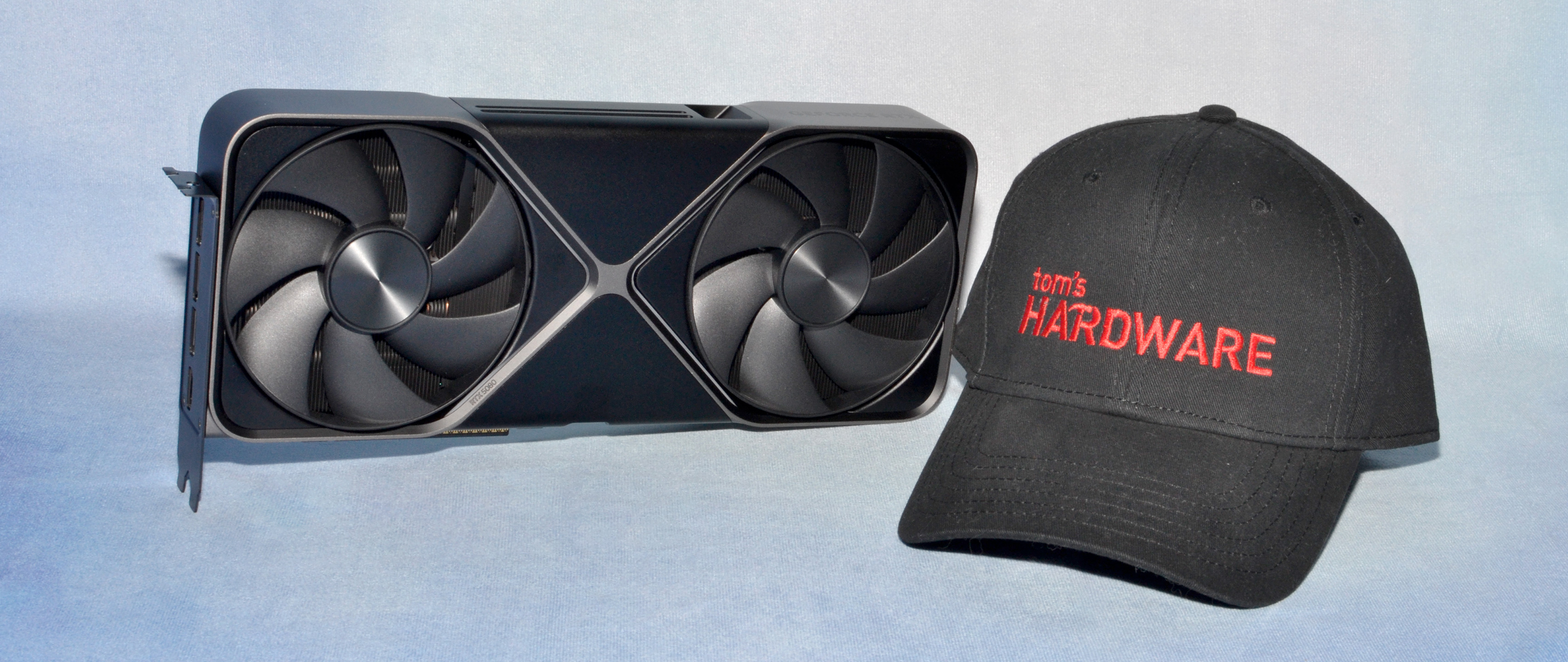Why you can trust Tom's Hardware
Nvidia RTX 5080 Ray Tracing Gaming Performance
Nvidia was the driving force behind the creation of DirectX Raytracing (DXR) and related APIs like Vulkan Ray Tracing. It all started with the Turing RTX 20-series GPUs, with each subsequent generation doubling the ray/triangle intersection calculation rates (per RT core).
Not surprisingly, most RT games end up being better optimized for Nvidia GPUs, because Nvidia has been pushing the tech far more than AMD or Intel. We've selected six reasonably demanding RT games for our testing, and we'll have additional supplemental RT / full RT / DLSS 4 testing on the next page.
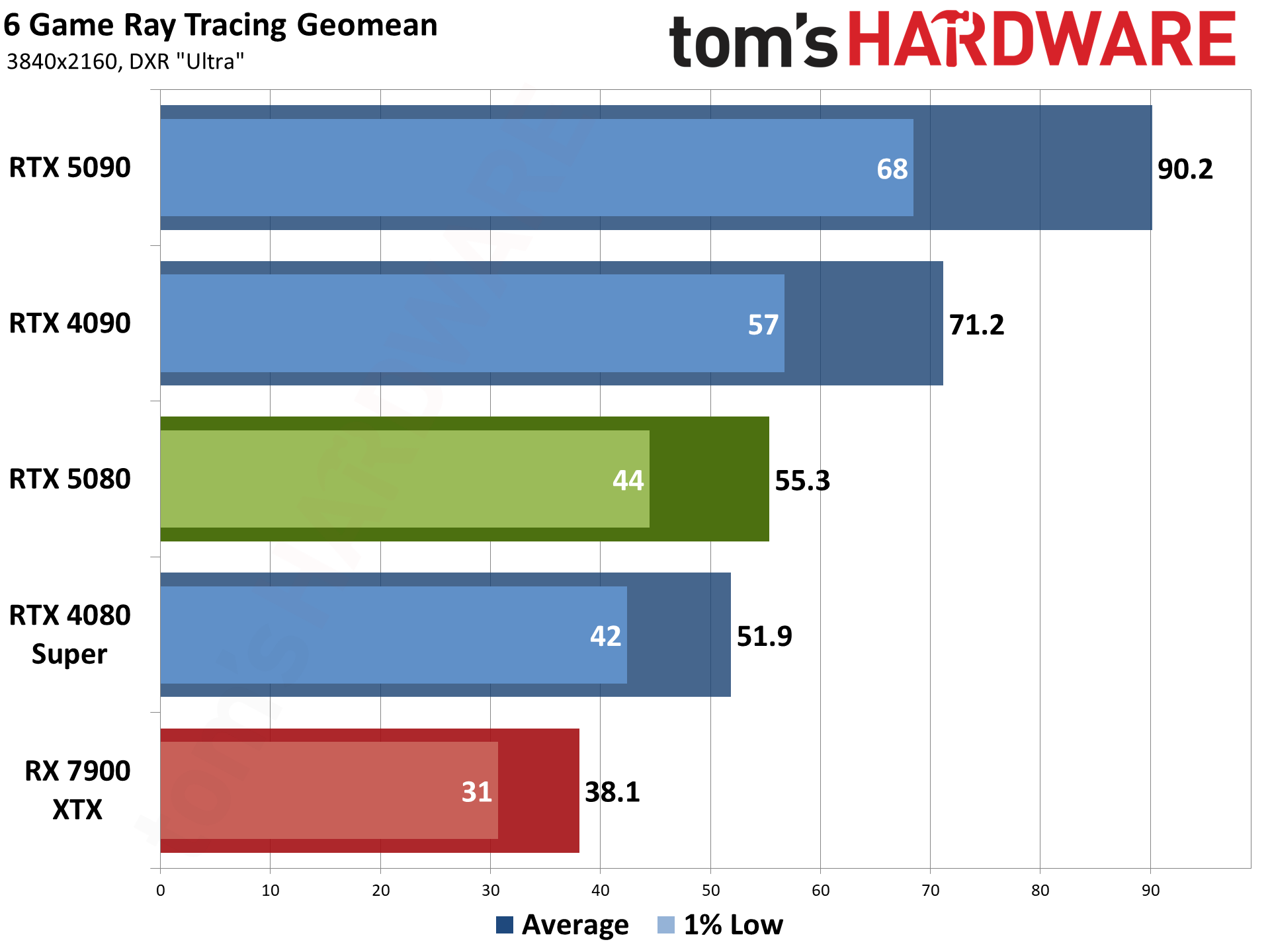
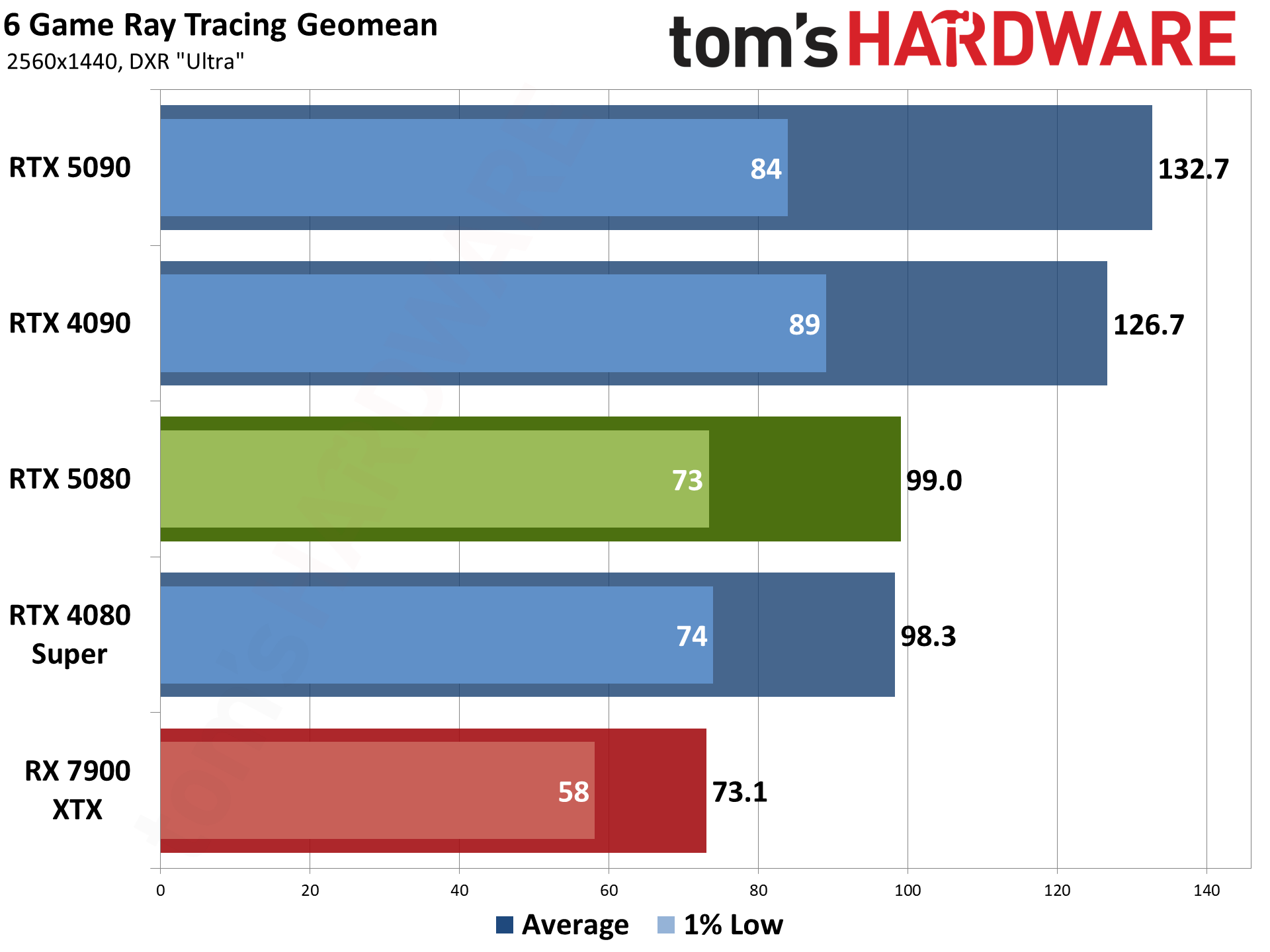

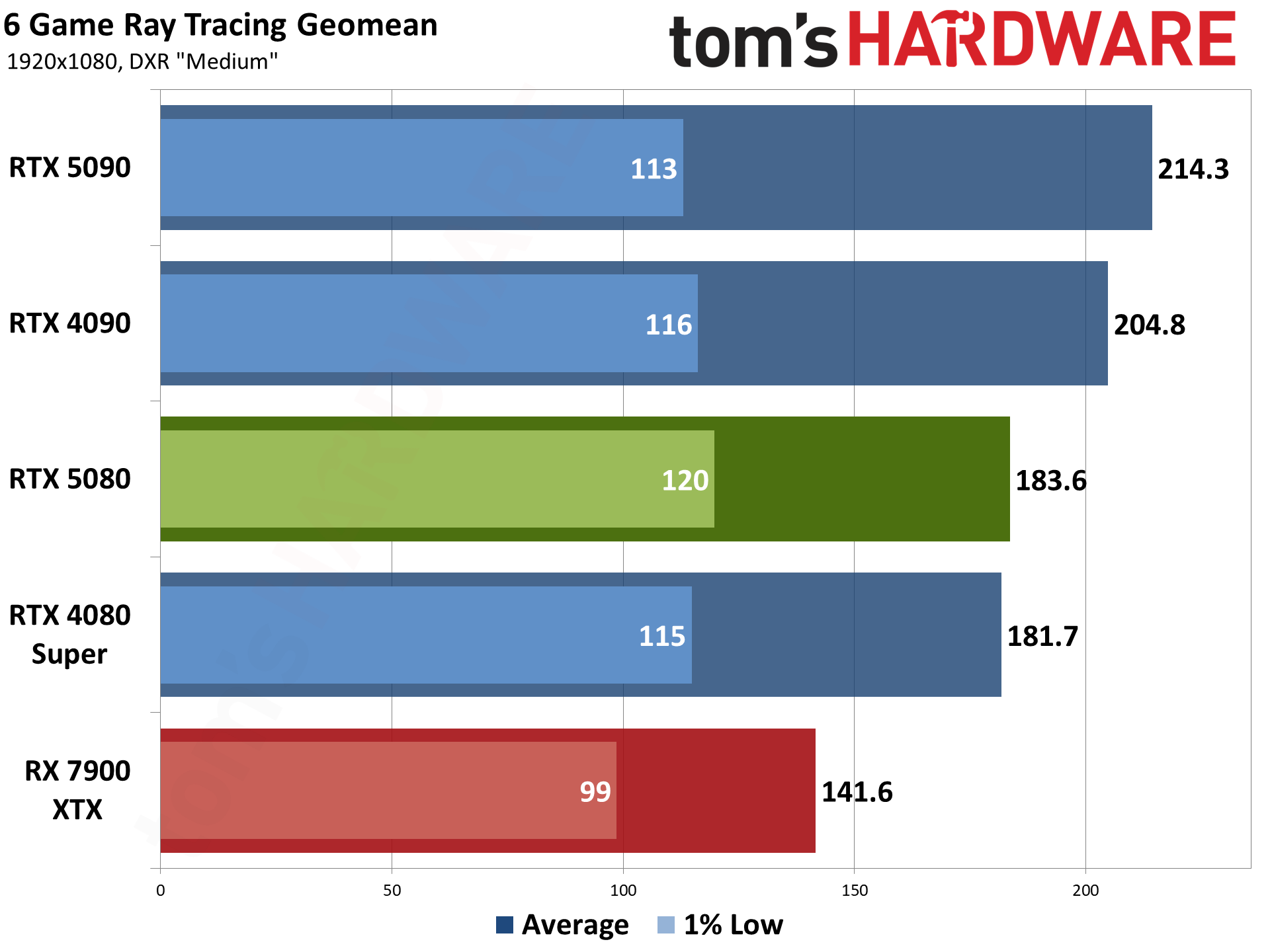
The RTX 5080, again, doesn't offer much compared to the prior generation in our DirectX Raytracing (DXR) test suite. Control ends up being the best result, mostly, with 16% higher performance at 4K. But Minecraft has a bug right now where performance on the RTX 5090 and 5080 is basically all kinds of messed up. That drags down the overall result.
Toss Minecraft out of the equation, for now, and the 5080 sees a 10% performance improvement over the 4080 Super at 4K, 8% at 1440p, and 7% at 1080p ultra — but only 3% at 1080p medium. Basically, you want to be gaming at 1440p or 4K before a GPU like the 5080 makes much sense.
Looking at AMD's RX 7900 XTX, which will likely remain the fastest GPU from Team Red for at least the next year based on what we're hearing about RDNA4 GPUs, it's no surprise that the 5080 easily beats AMD's fastest solution. Even Minecraft is mostly faster (1080p "ultra" was slower), and overall, the 5080 delivers roughly 25–45 percent higher ray tracing performance than the 7900 XTX.
Outside Minecraft, most of these games still only do modest amounts of RT. We'll check some full RT games on the next page as well to see if the Blackwell GPUs see larger gains.
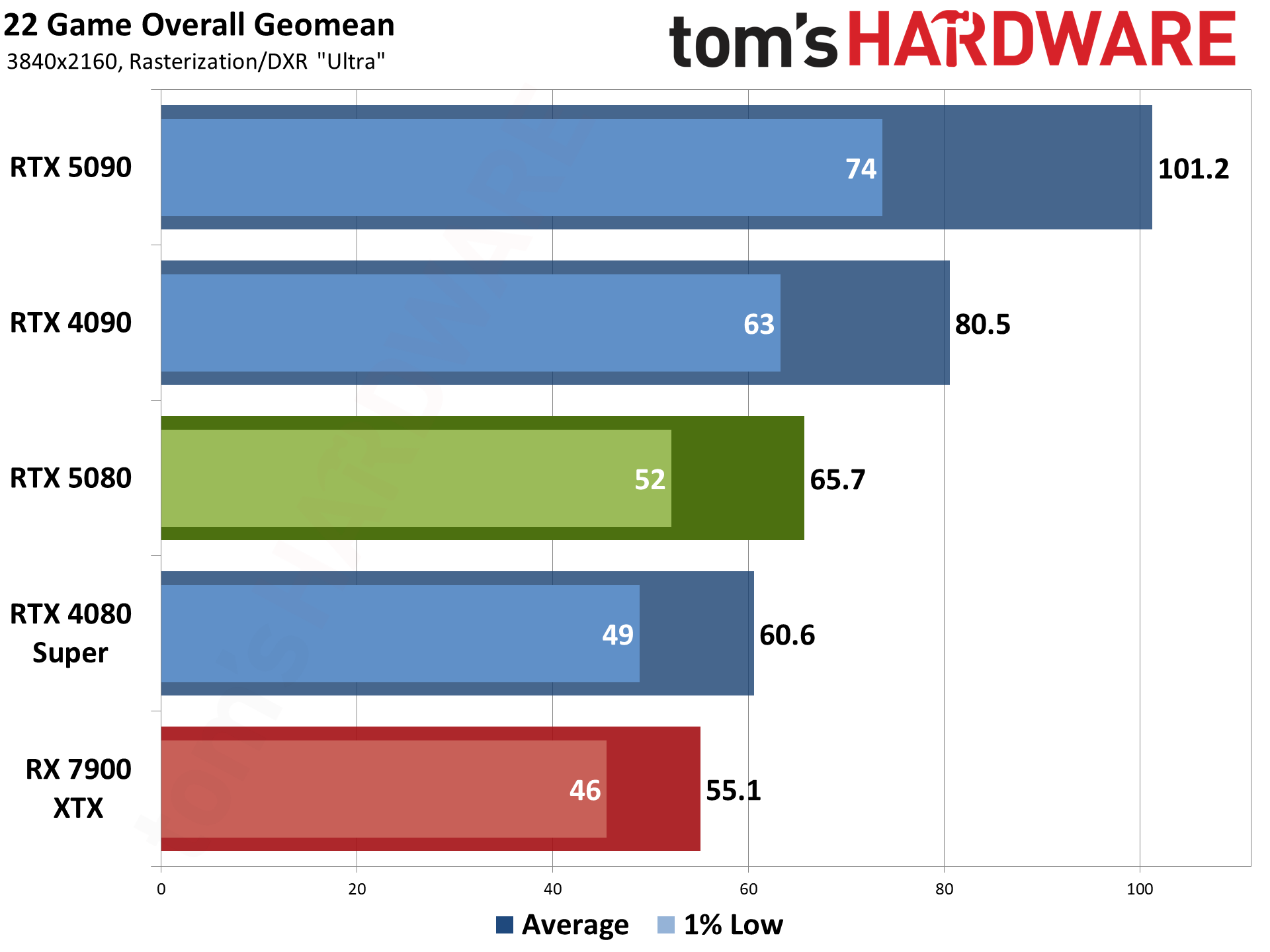
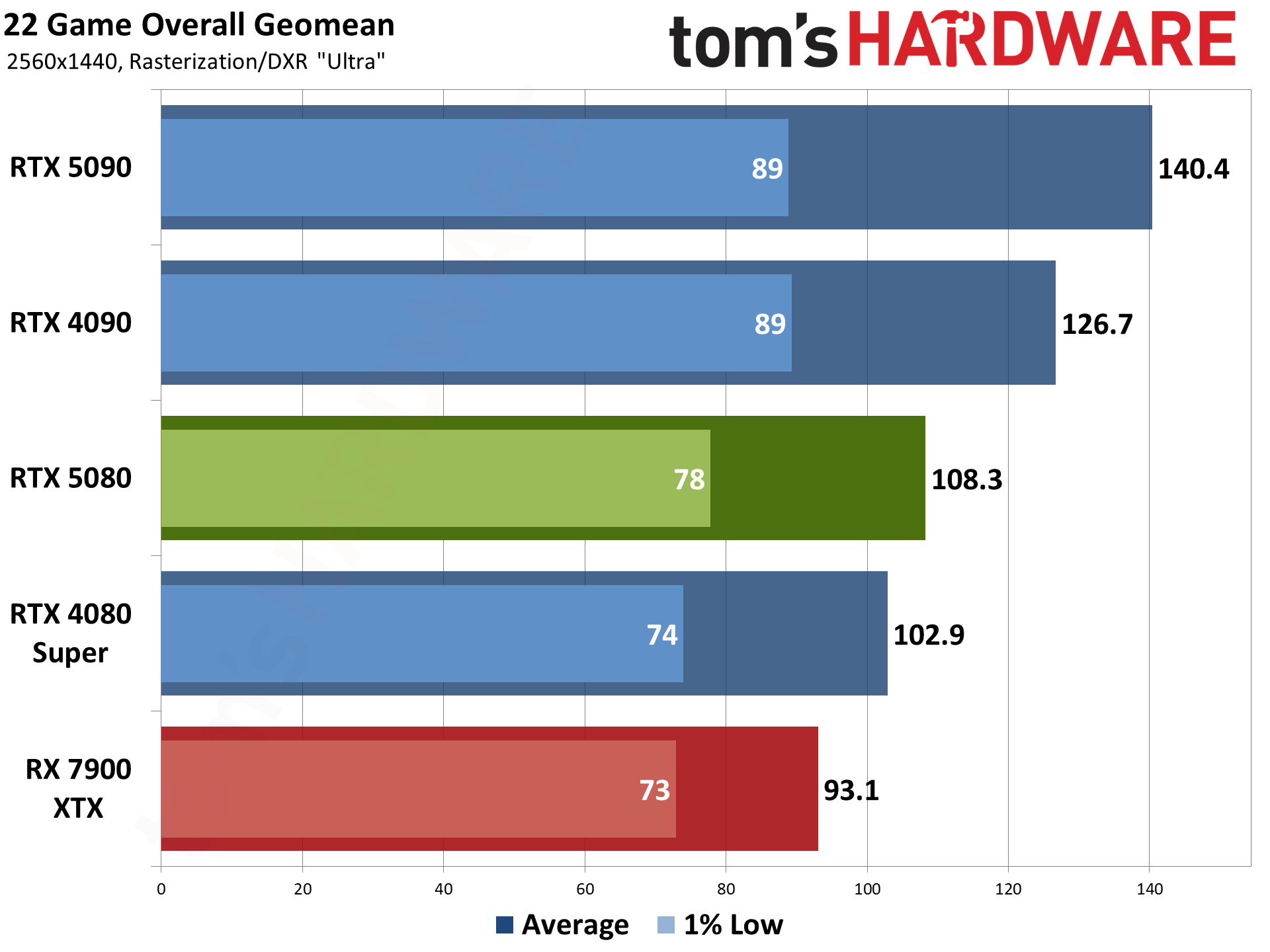
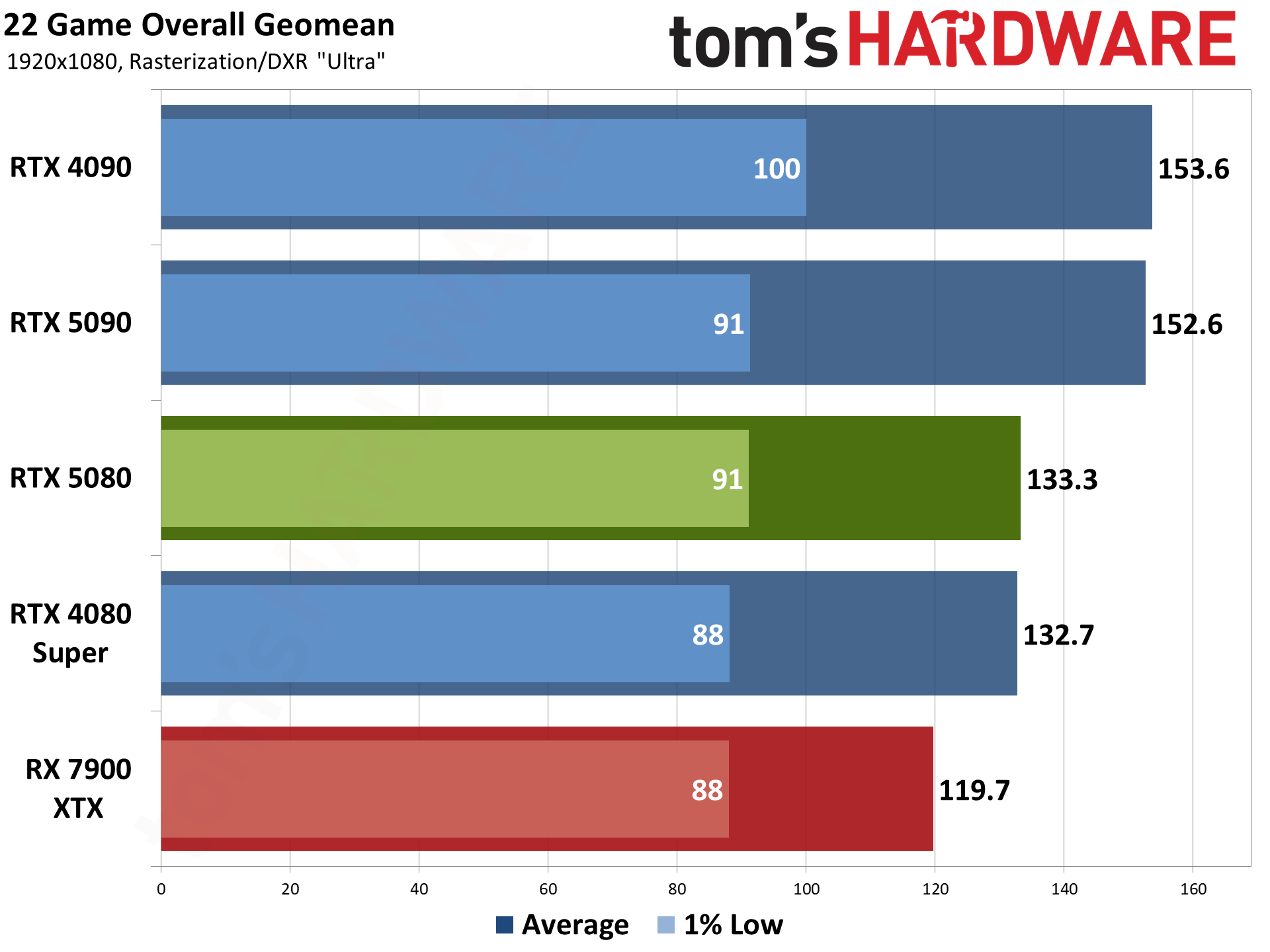
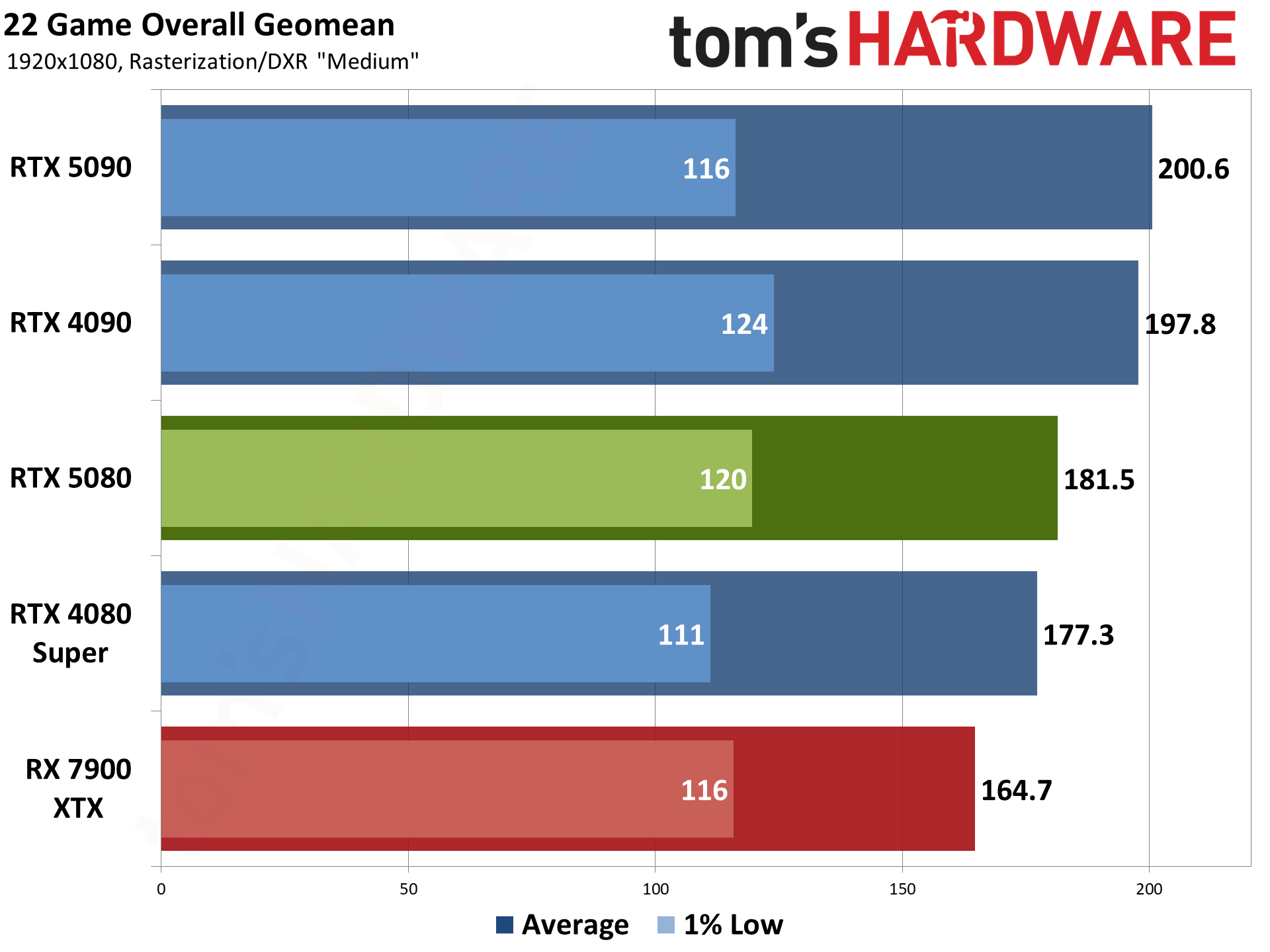
Here are the combined rasterization plus ray tracing overall results charts. These charts use the geomean of all 22 games we tested, with RT accounting for slightly more than a quarter of the overall score.
There are a few games where performance on the 5080 and 5090 looks to be off, due to the new architecture and need for further driver tuning. As with the RT result above, those games drag down the overall average a bit, especially at 1080p.
The RTX 5080 ends up 8.5% ahead of the 4080 Super at 4K, 5.2% faster at 1440p, tied at 1080p ultra, and 2.4% faster at 1080p medium. If we discount the problematic Minecraft (the worst offender for driver bugs right now), the overall delta improves by 1–3 percent at the various resolutions.
AMD's 7900 XTX fared better in the rasterization testing, so the 5080 only leads by 10–20 percent in our overall metric.
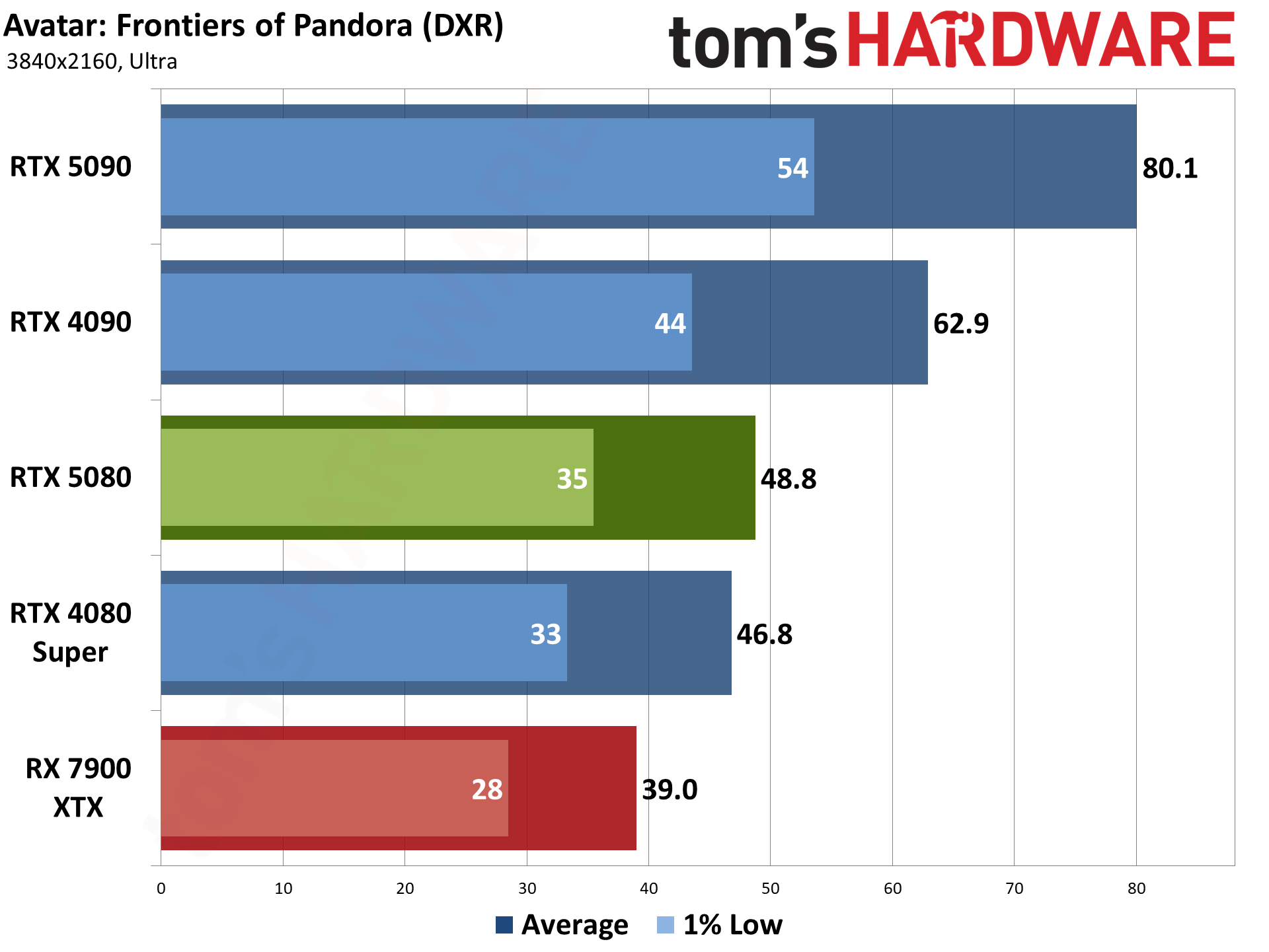
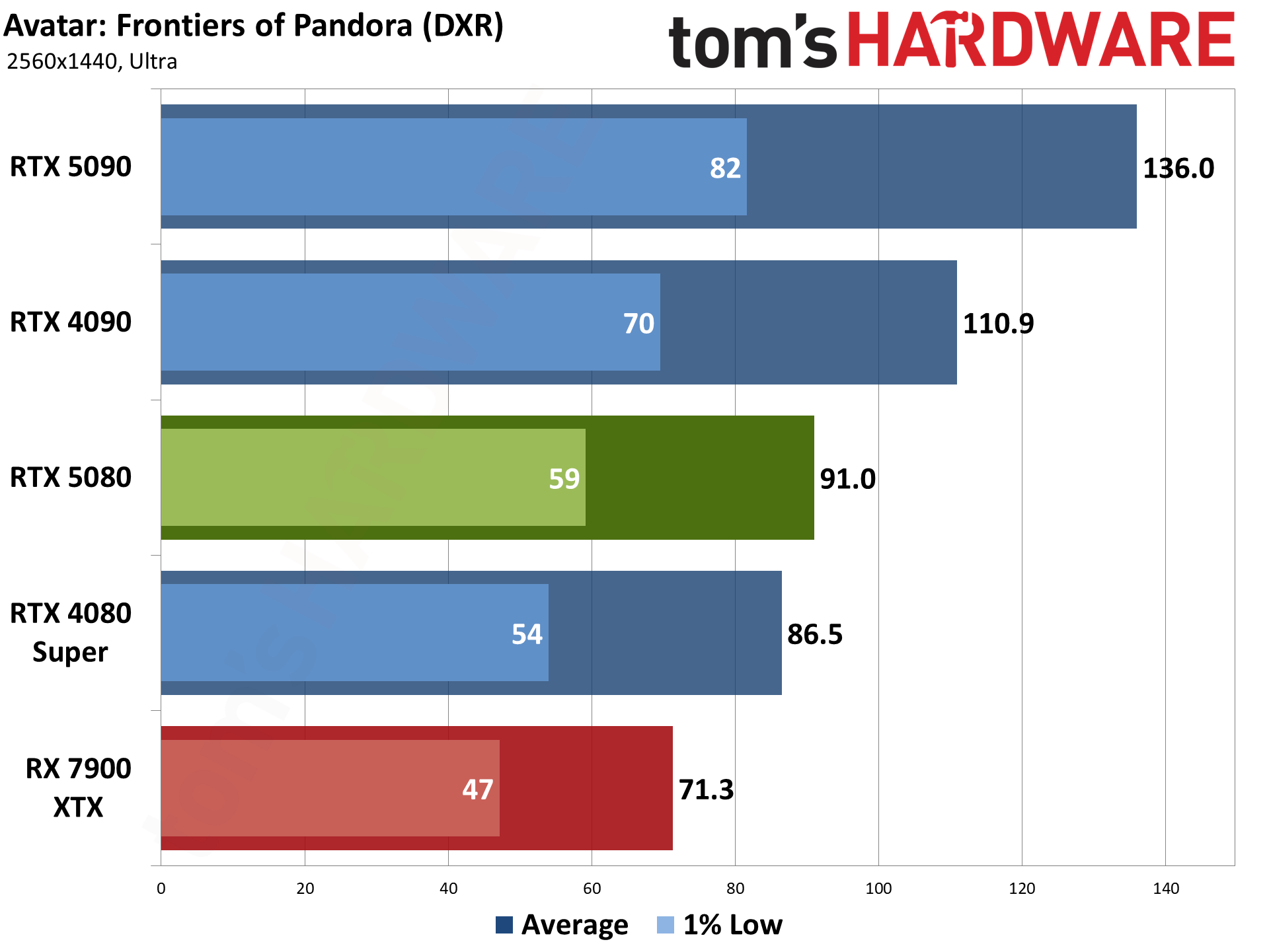
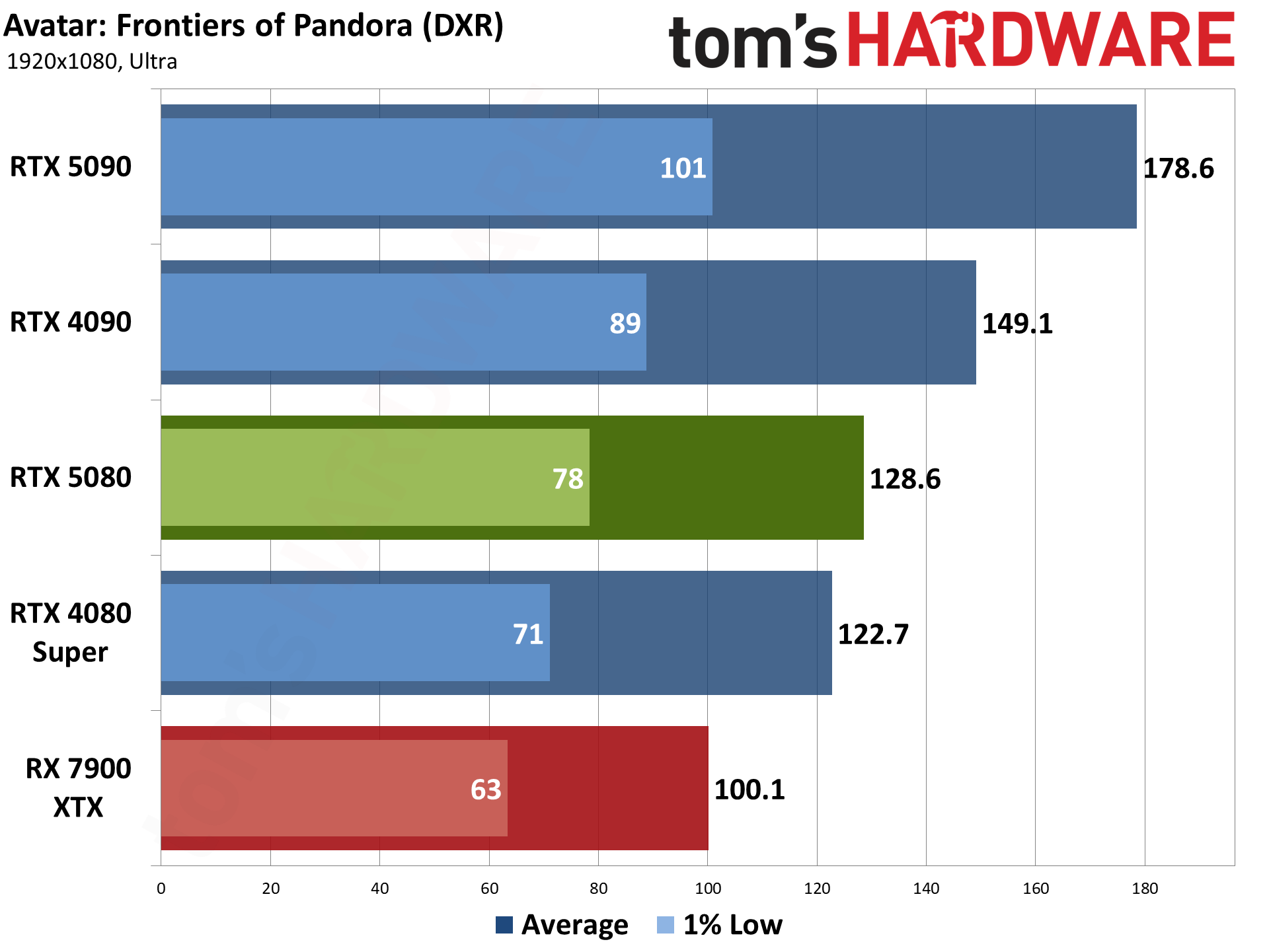
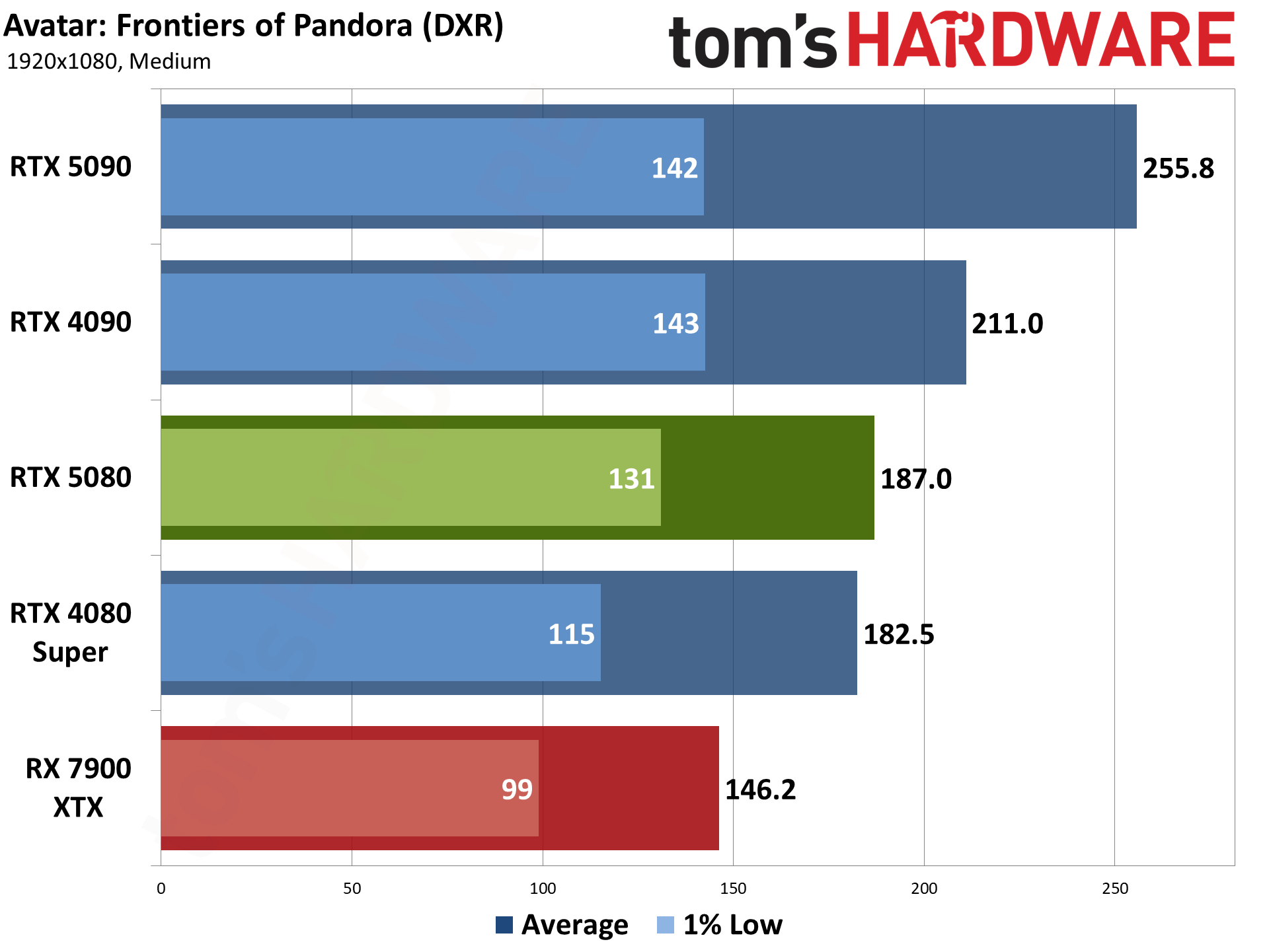
Avatar: Frontiers of Pandora uses ray tracing, but it's not particularly forthcoming on when and where it's used. Reflections, in general, don't appear to use RT, which is one of the most noticeable upgrades RT can provide. Instead, it's used for shadows and possibly global illumination and some other effects. What I can say for sure is that nothing in the menus (other than "BVH Quality") directly mentions ray tracing, and the performance hit doesn't seem to be as severe as in some games.
Still, since there's RT of some form, this one gets lumped into our DXR suite. Note also how the AMD 7900 XTX lags behind the 4080 Super across all tested resolutions and settings — a key giveaway is that this (AMD-promoted) game uses ray tracing.
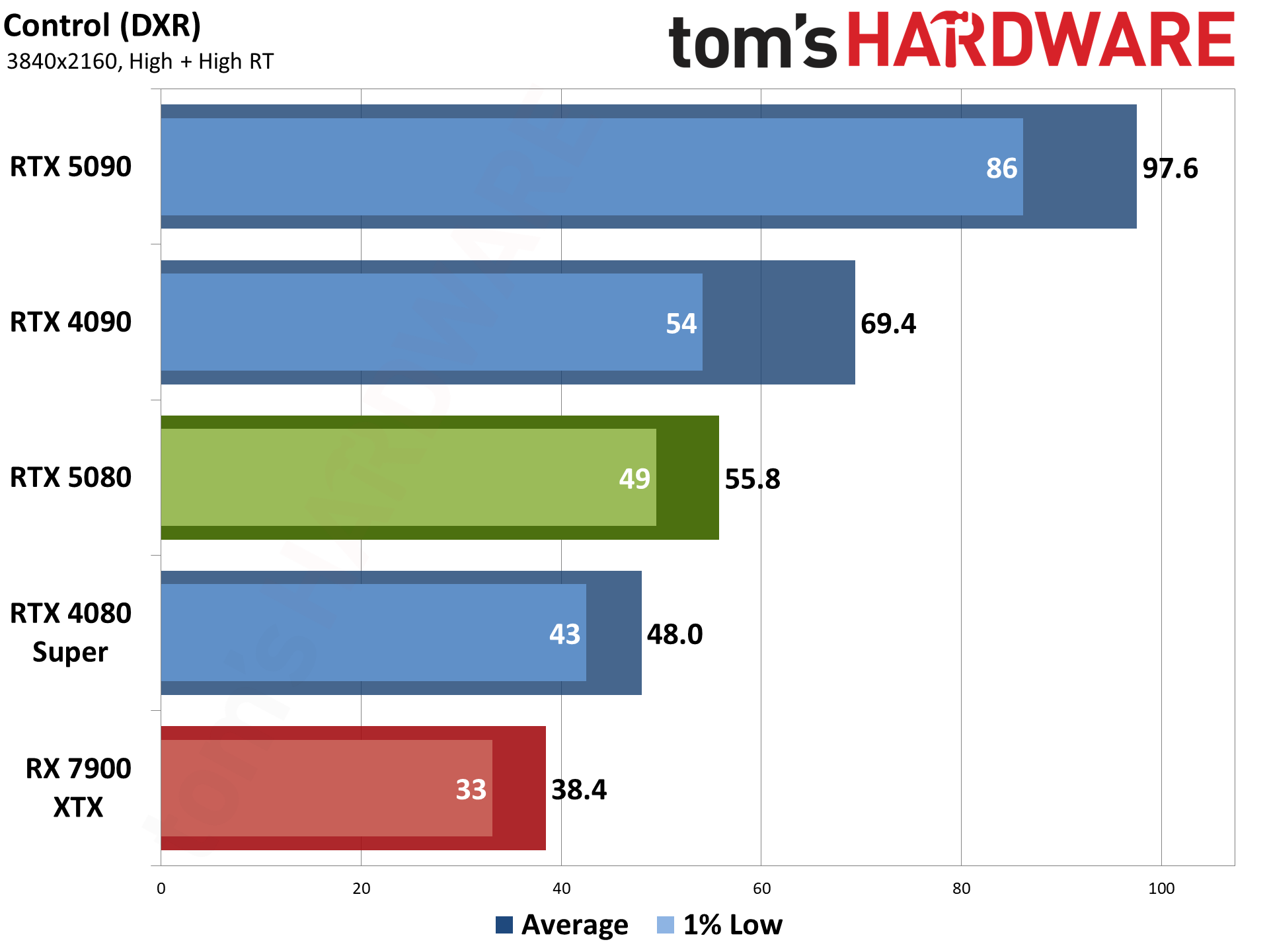
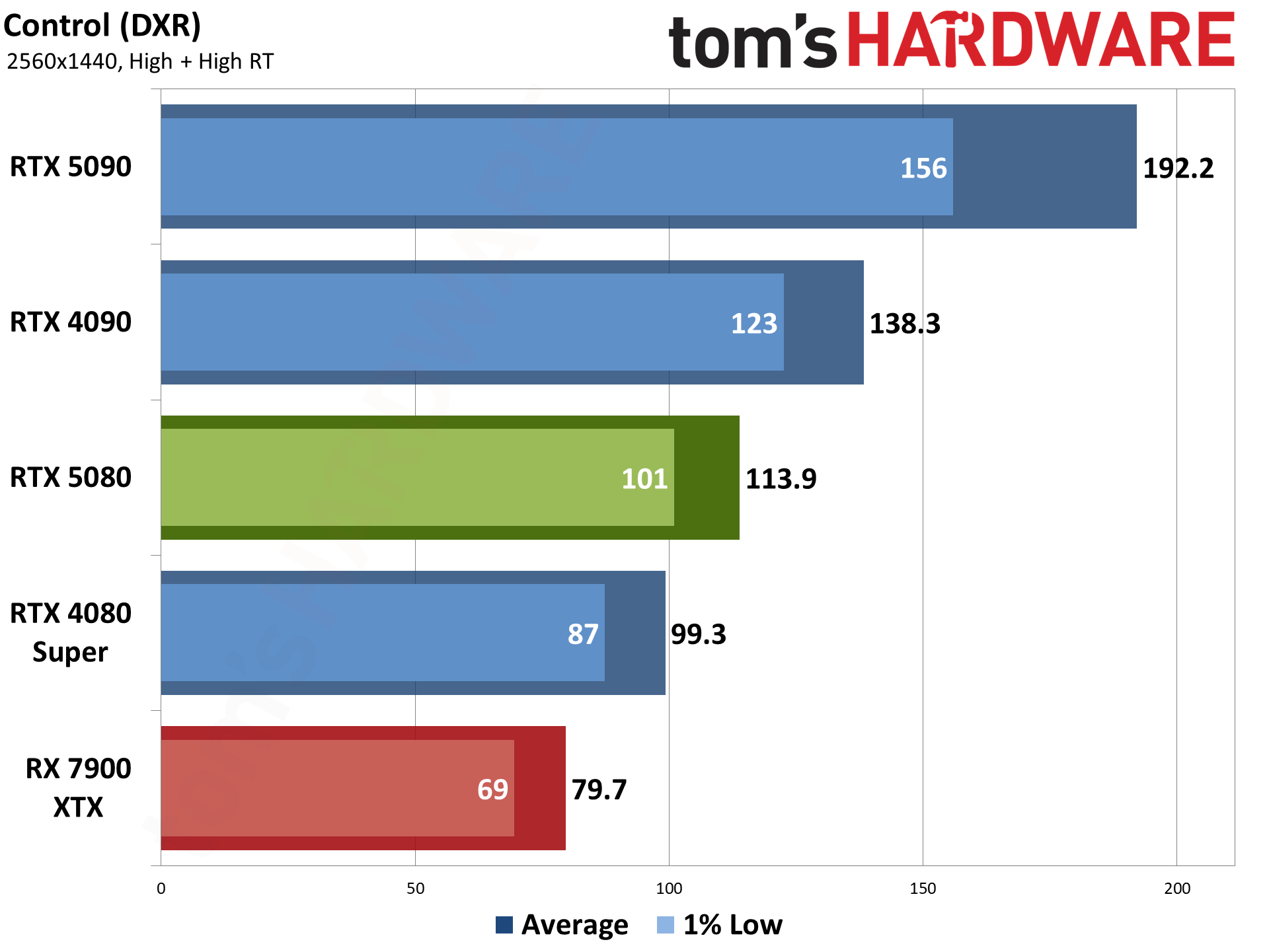
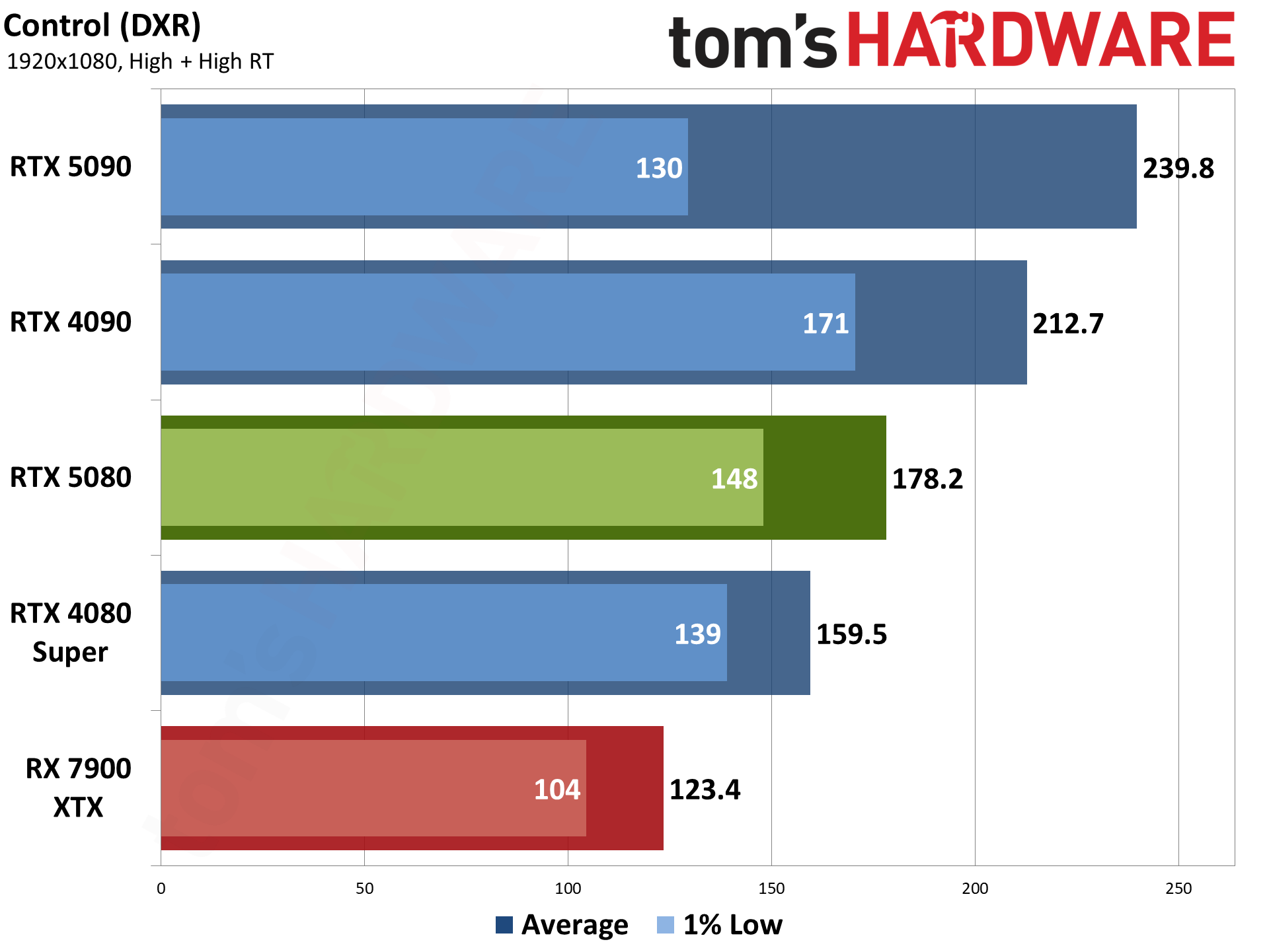

If you want a game where ray tracing is both clearly visible and actually makes the game look better, without totally destroying performance, look no further than Control. It's now five years old, and we're using the Ultimate version, but it's still arguably the best example of using RT well. And probably a lot of that is because you're running around the Federal Bureau of Control, an office space of sorts that has good reasons to have plenty of glass windows that reflect the scenery.
The RTX 5080 has some rendering errors in Control right now, and there's a hard 240 FPS cap that impacts the 1080p results. But the 1440p and 4K results are valid across all the GPUs we've tested here, with the 5080 beating the 4080 Super by about 15%.

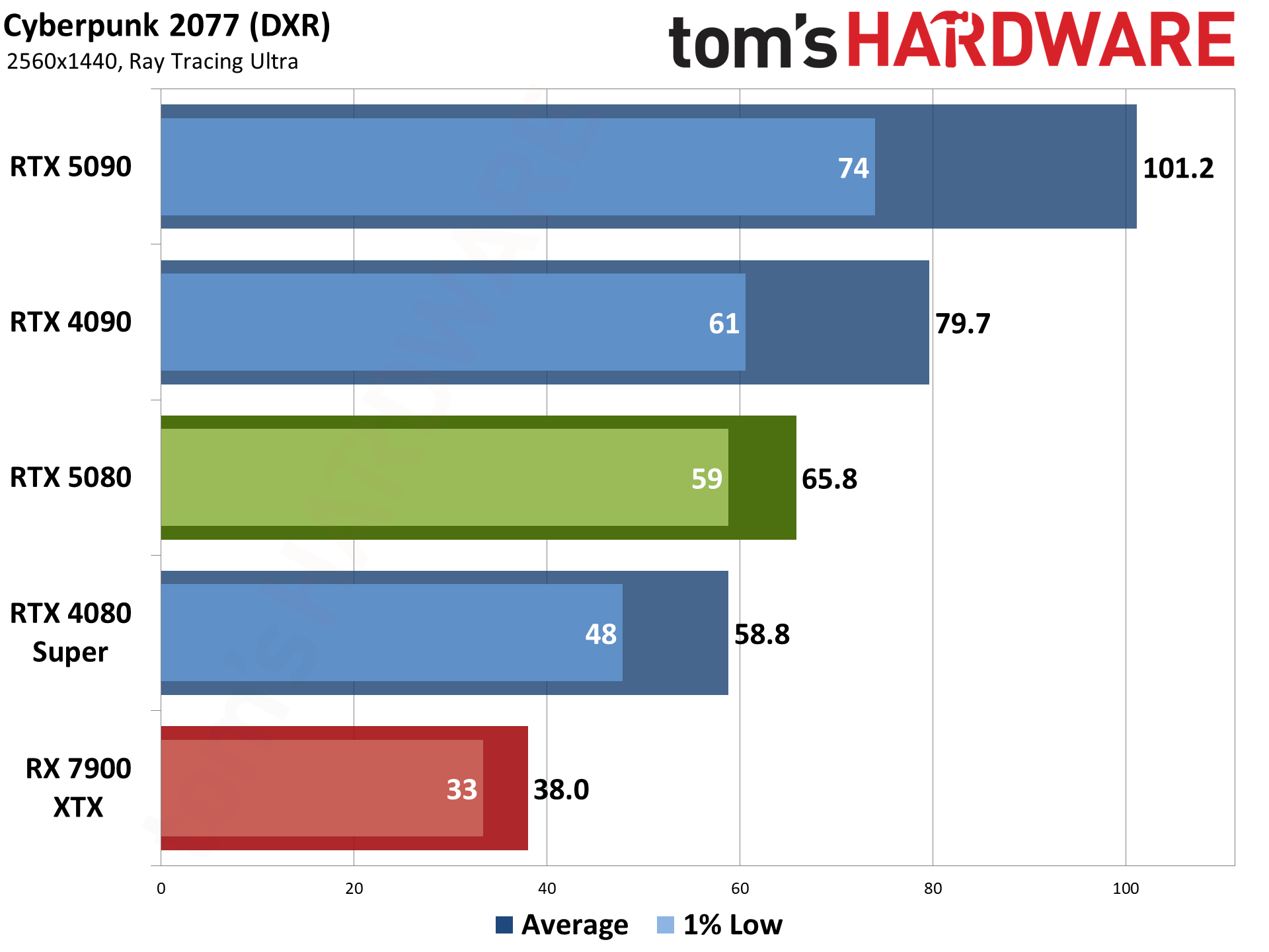
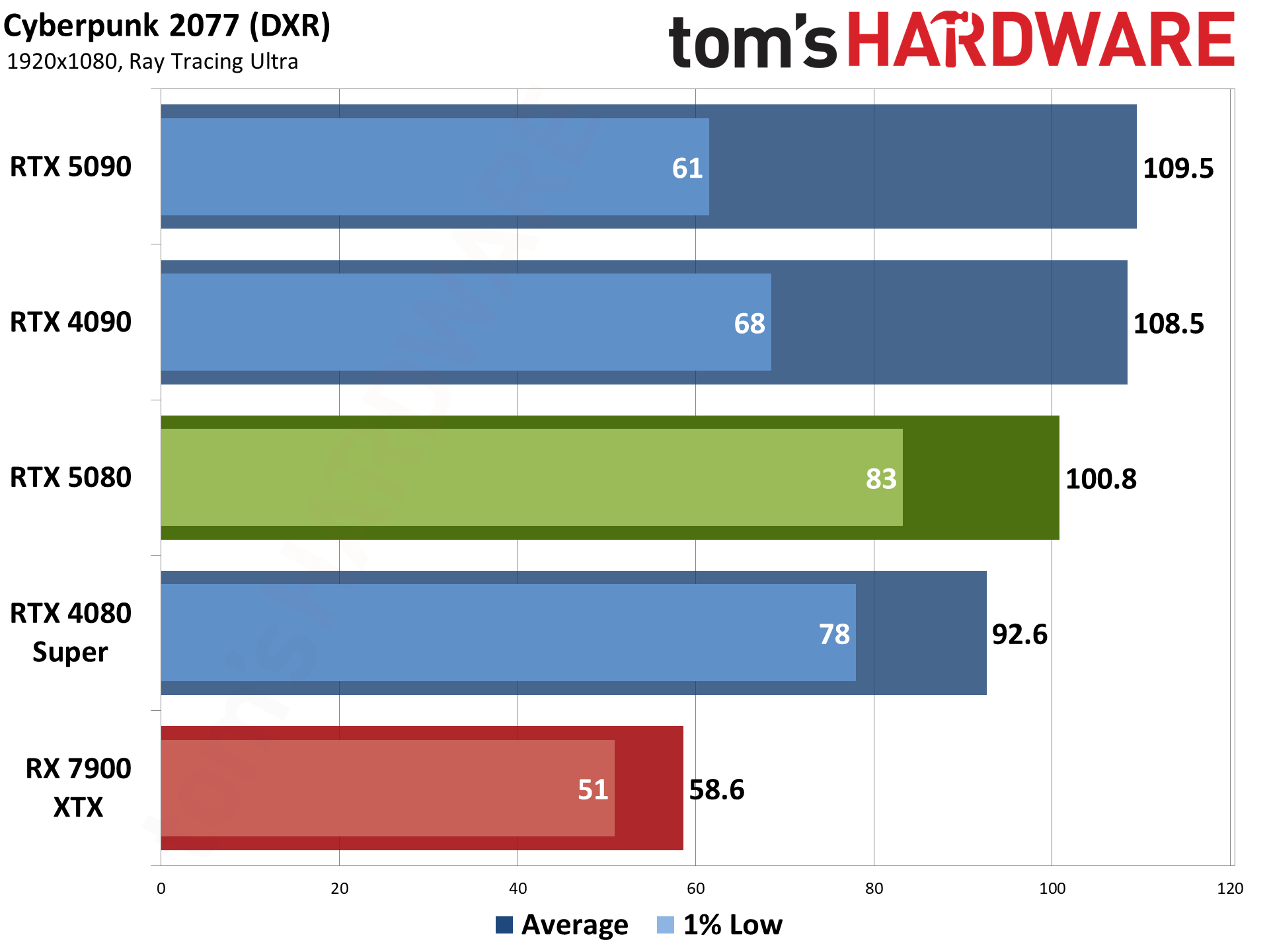
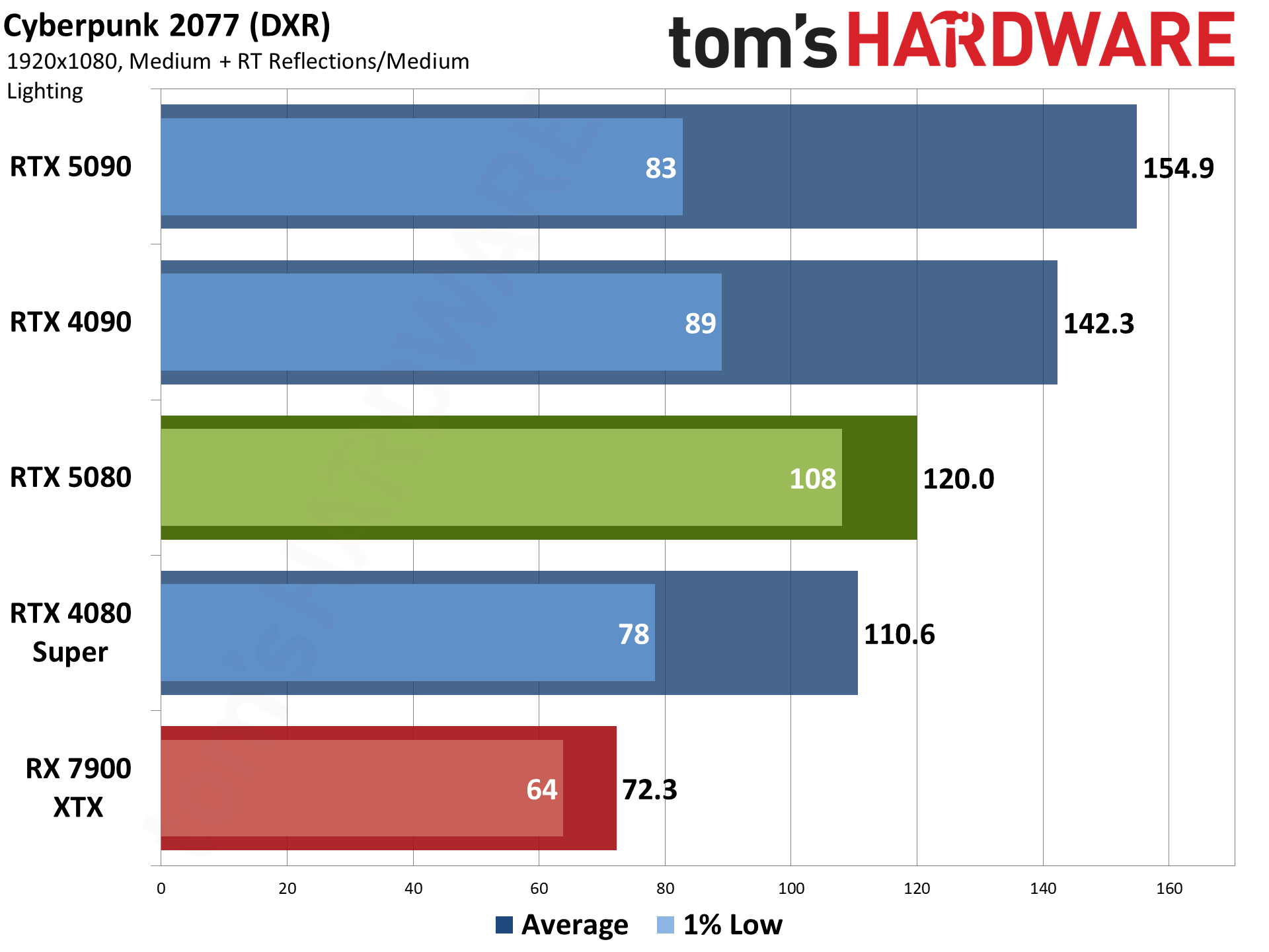
Possibly the most hyped-up use of RT in a game, Cyberpunk 2077 launched with more RT effects than other games of its era, and later, the 2.0 version added full path tracing and DLSS 3.5 ray reconstruction. Ray reconstruction ends up looking the best but only works on Nvidia GPUs, so, as with upscaling, it can be a case of trying to compare apples and oranges.
We're using medium settings with RT lighting at medium and RT reflections enabled, and then the step up uses the RT-Ultra preset. In all cases, any form of upscaling or frame generation gets turned off. However, we'll have more details on Cyberpunk 2077 with RT-Overdrive on the next page. It's also currently the only game with a public release that supports DLSS 4.
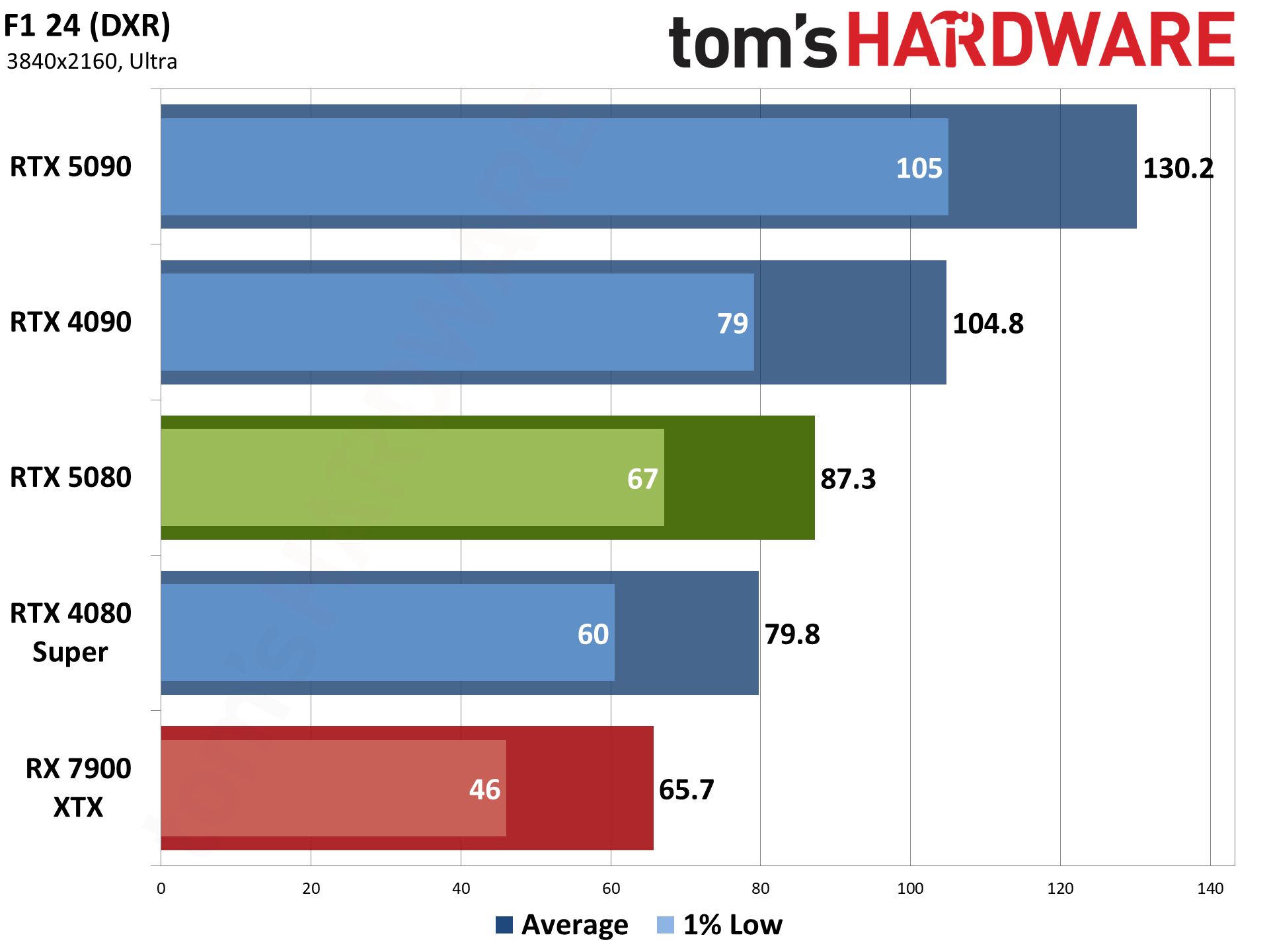
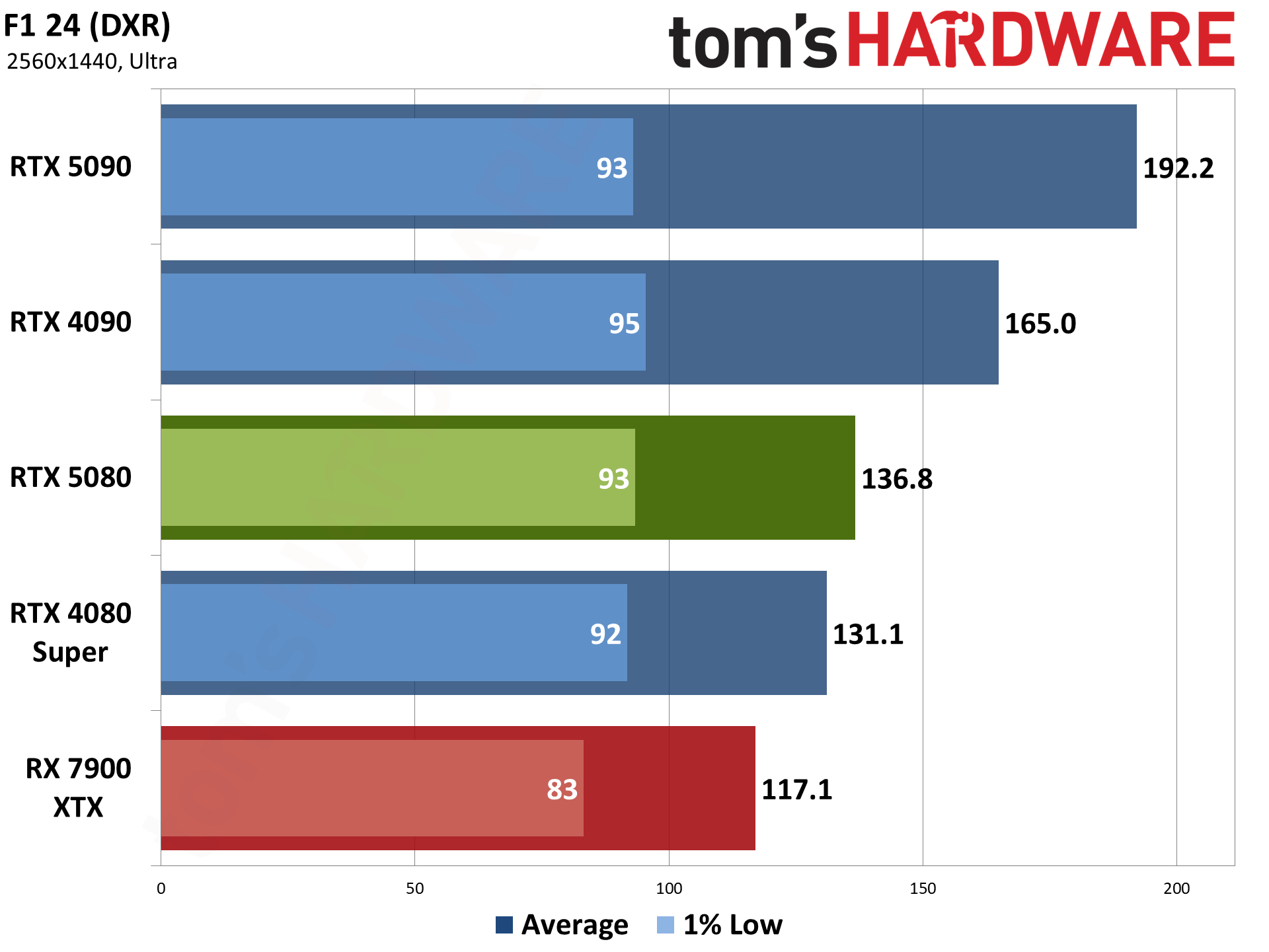
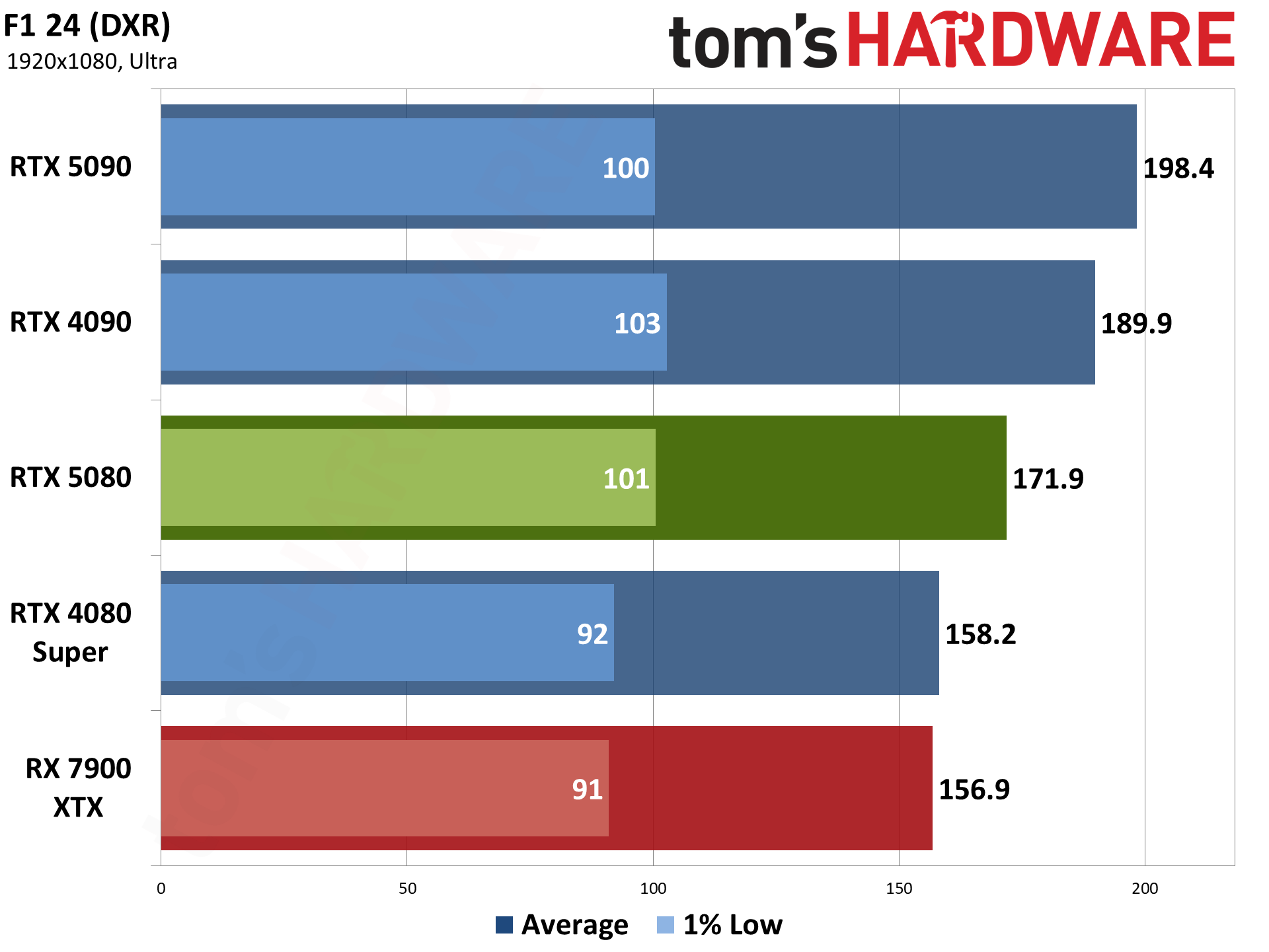
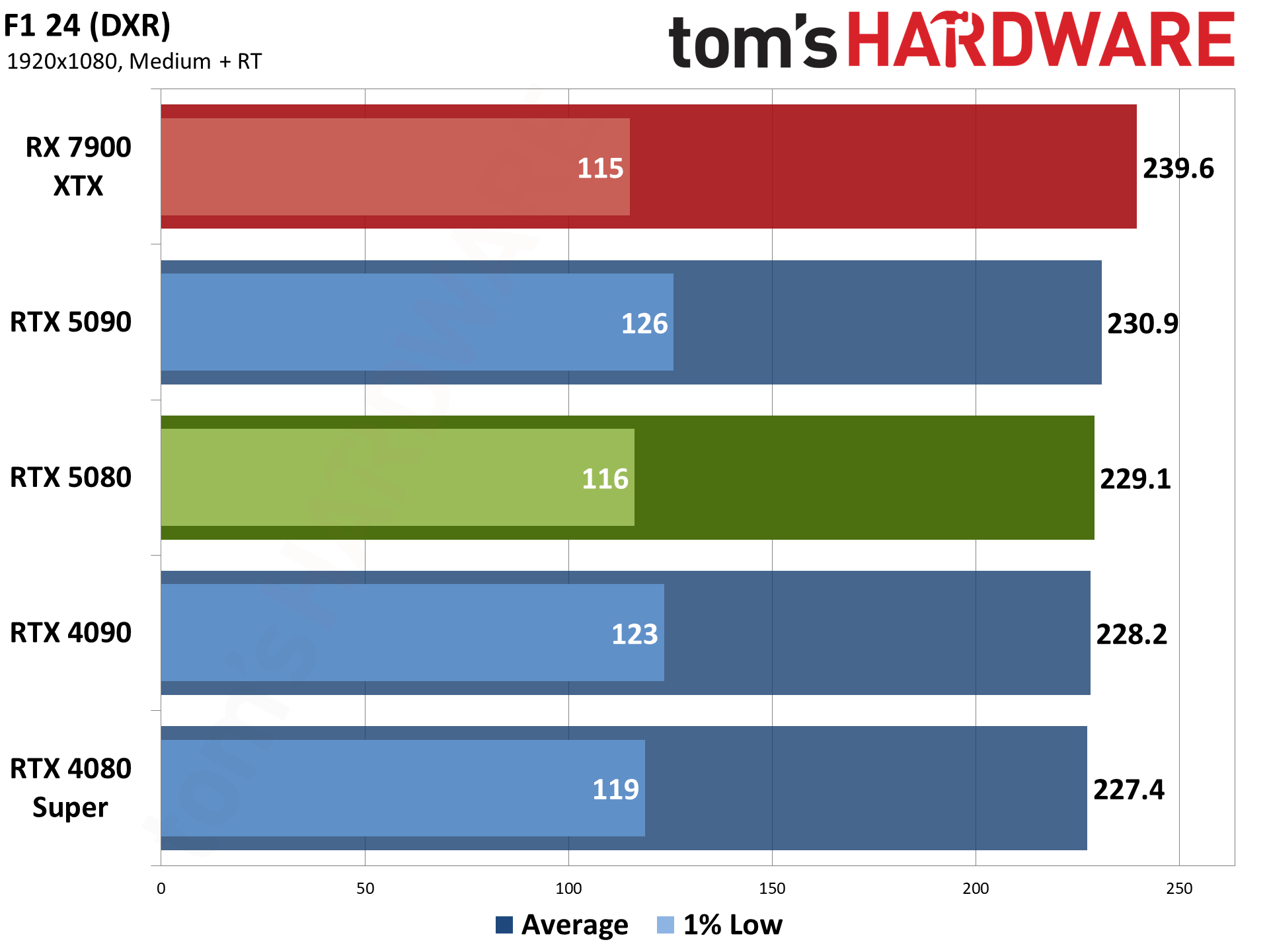
F1 24 enables several RT effects on the ultra preset but leaves them off on medium. But then 1080p medium runs at hundreds of frames per second, so we went ahead and turned all the RT effects on for our testing. We use the Great Britain track for testing, in the rain naturally.
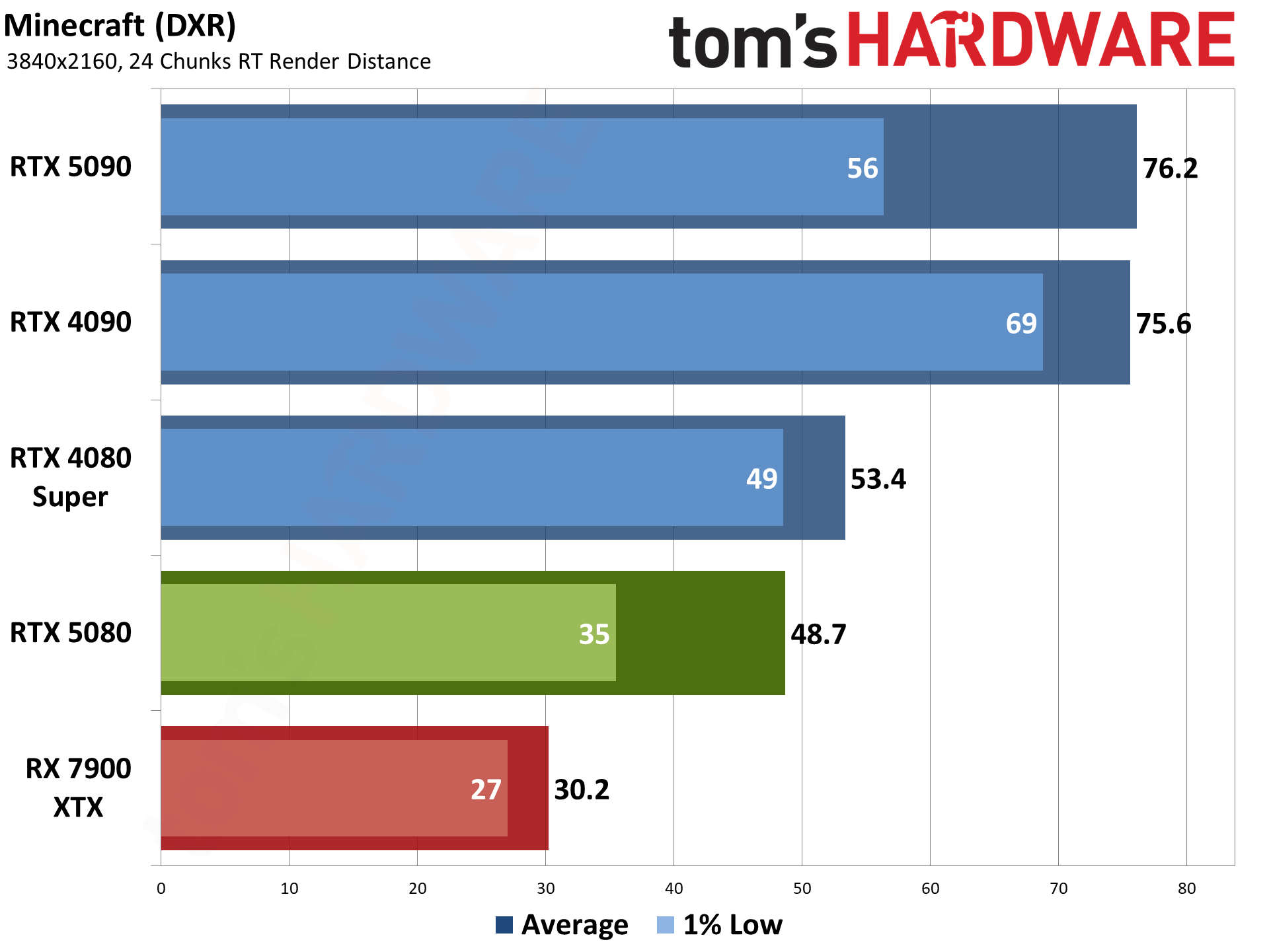
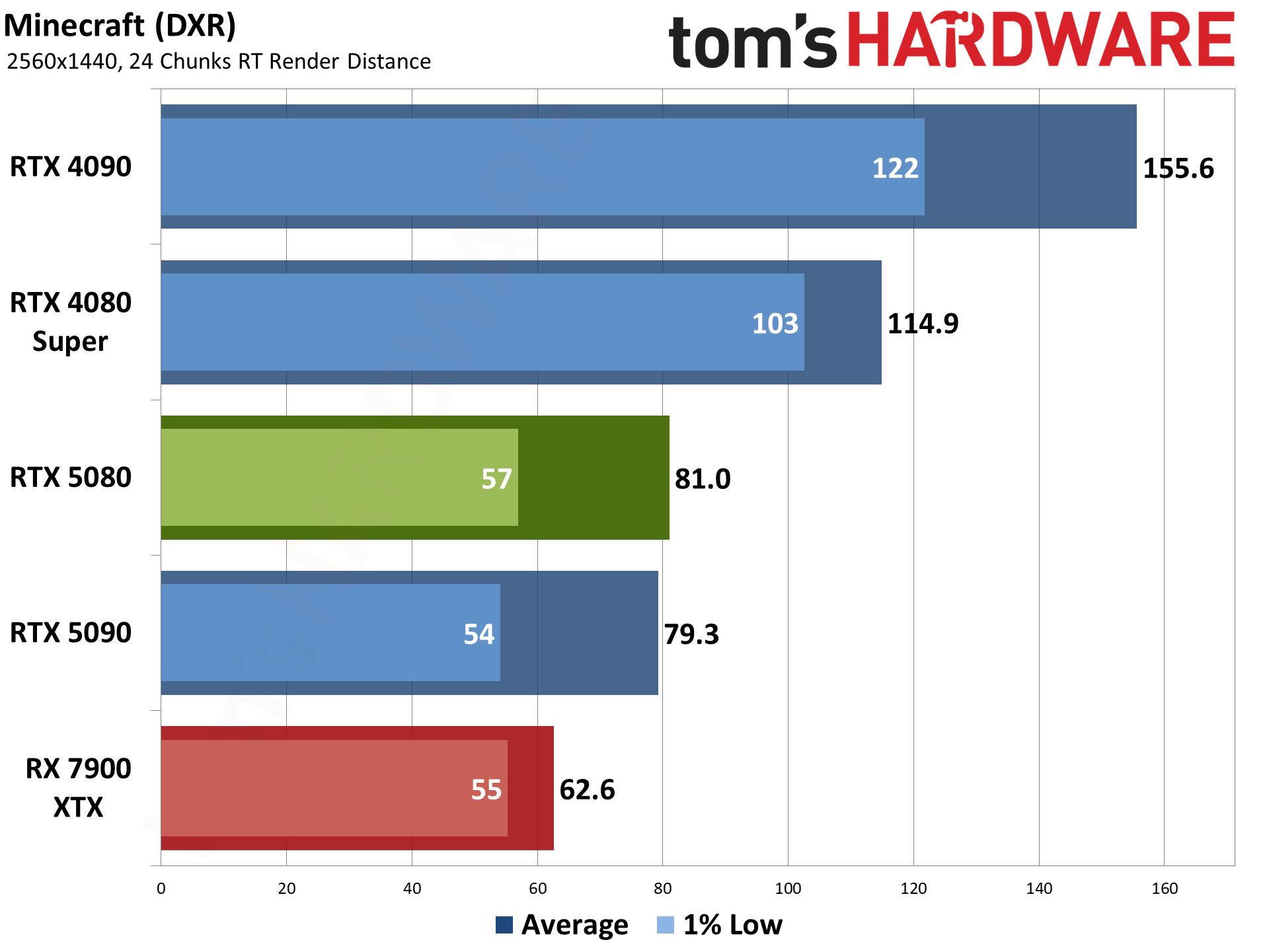
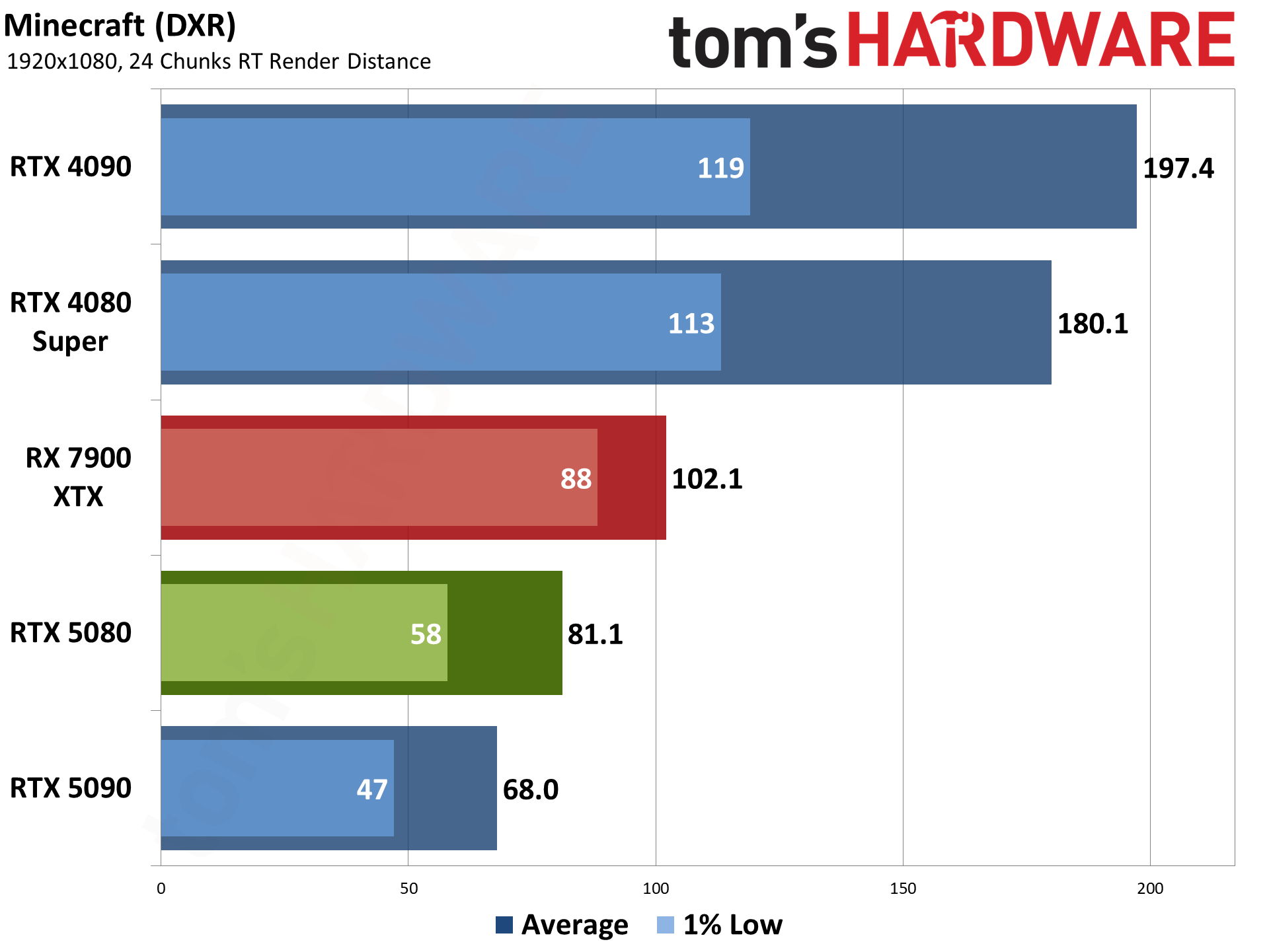
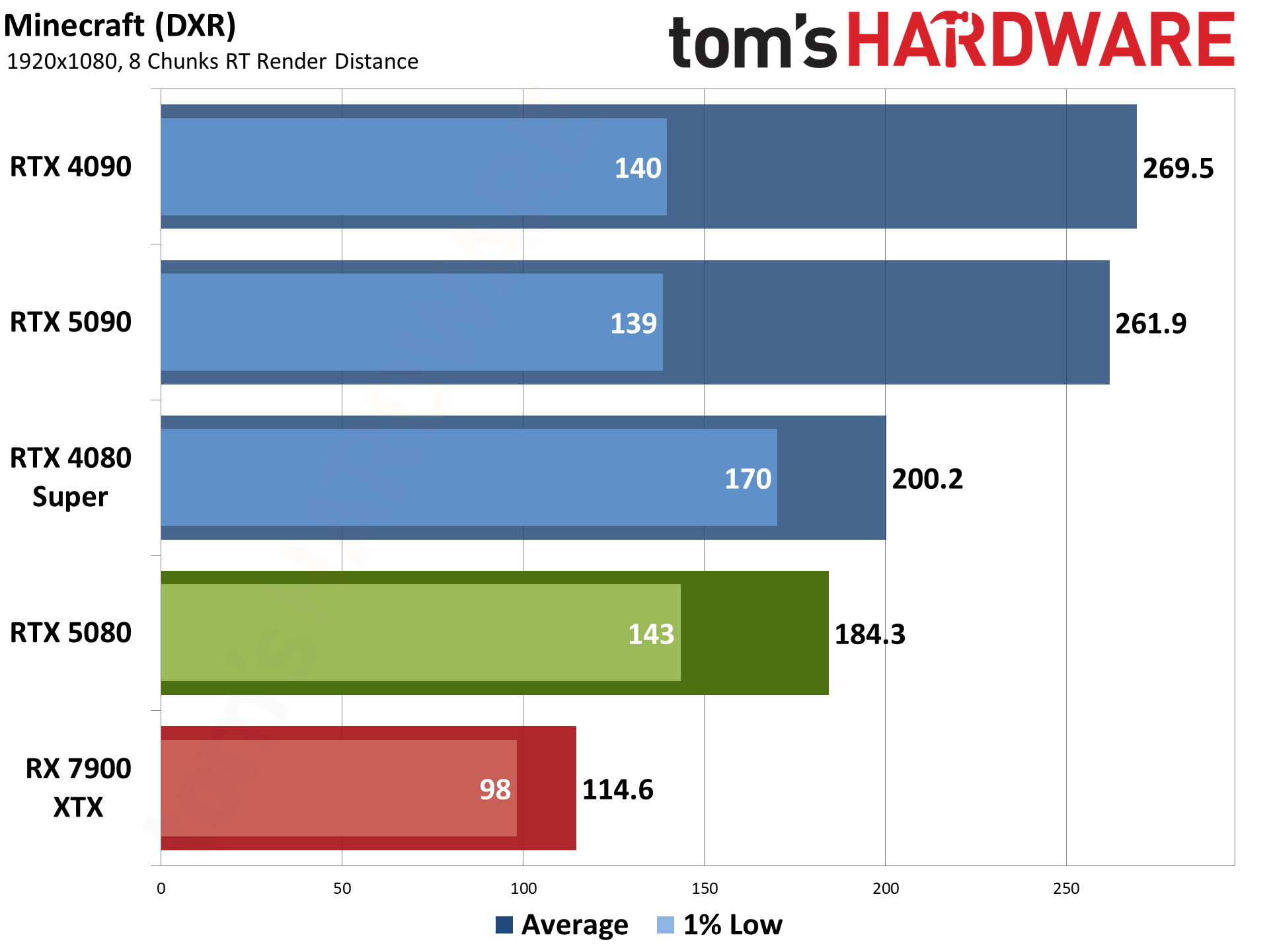
Minecraft supports full path tracing, as well as DLSS 2 upscaling on RTX cards. We don't enable DLSS, and the game doesn't even allow it on the RTX 50-series GPUs right now. Apparently, it has some sort of hard-coded check for an RTX 20-, 30-, or 40-series GPU is our best guess. Or it's just a driver bug of some form.
Both the 5080 and 5090 underperform in Minecraft by quite a lot — especially at 1080p. Nvidia is working on a fix, which will hopefully be in the first public driver when the cards launch tomorrow.
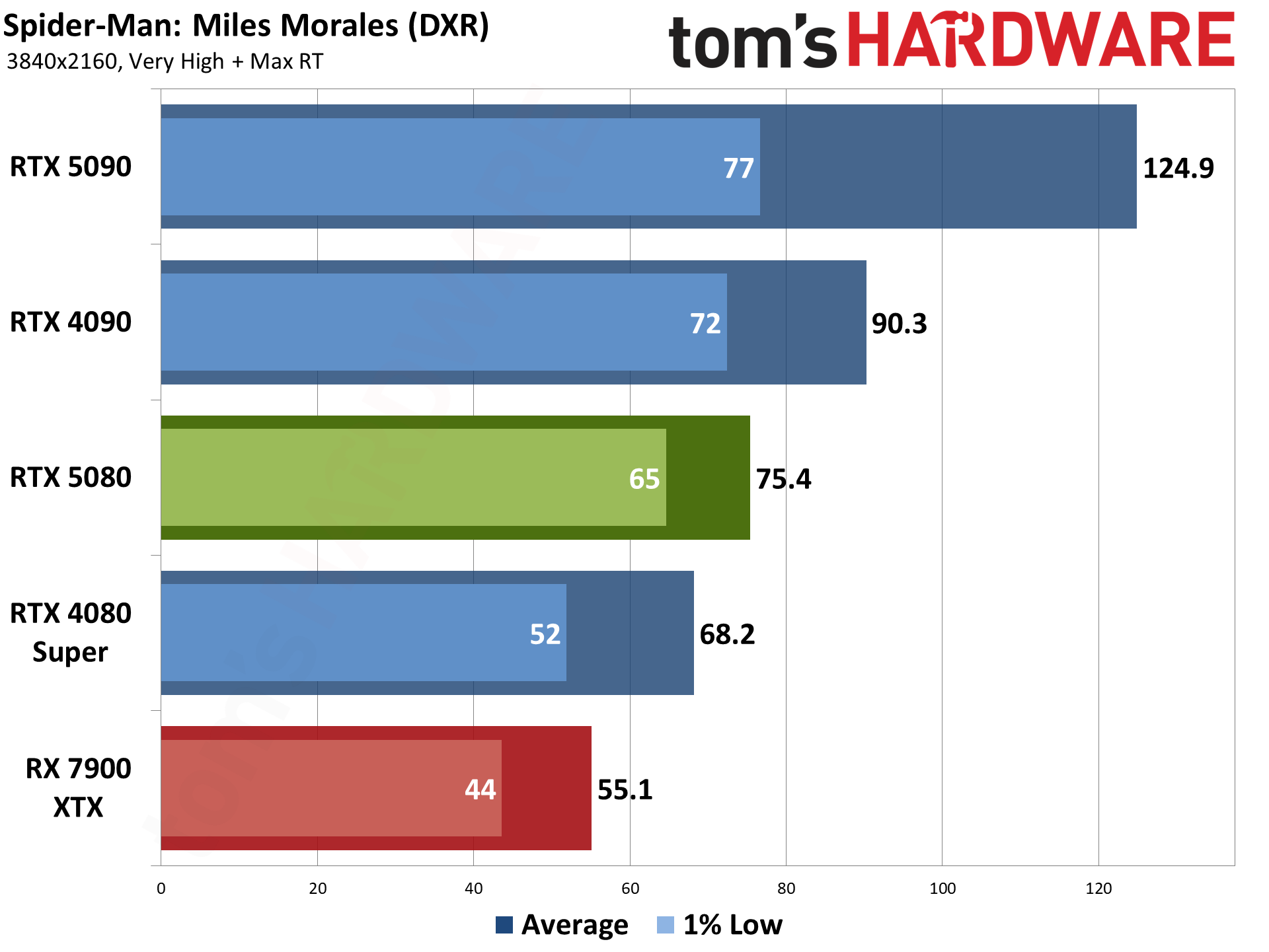
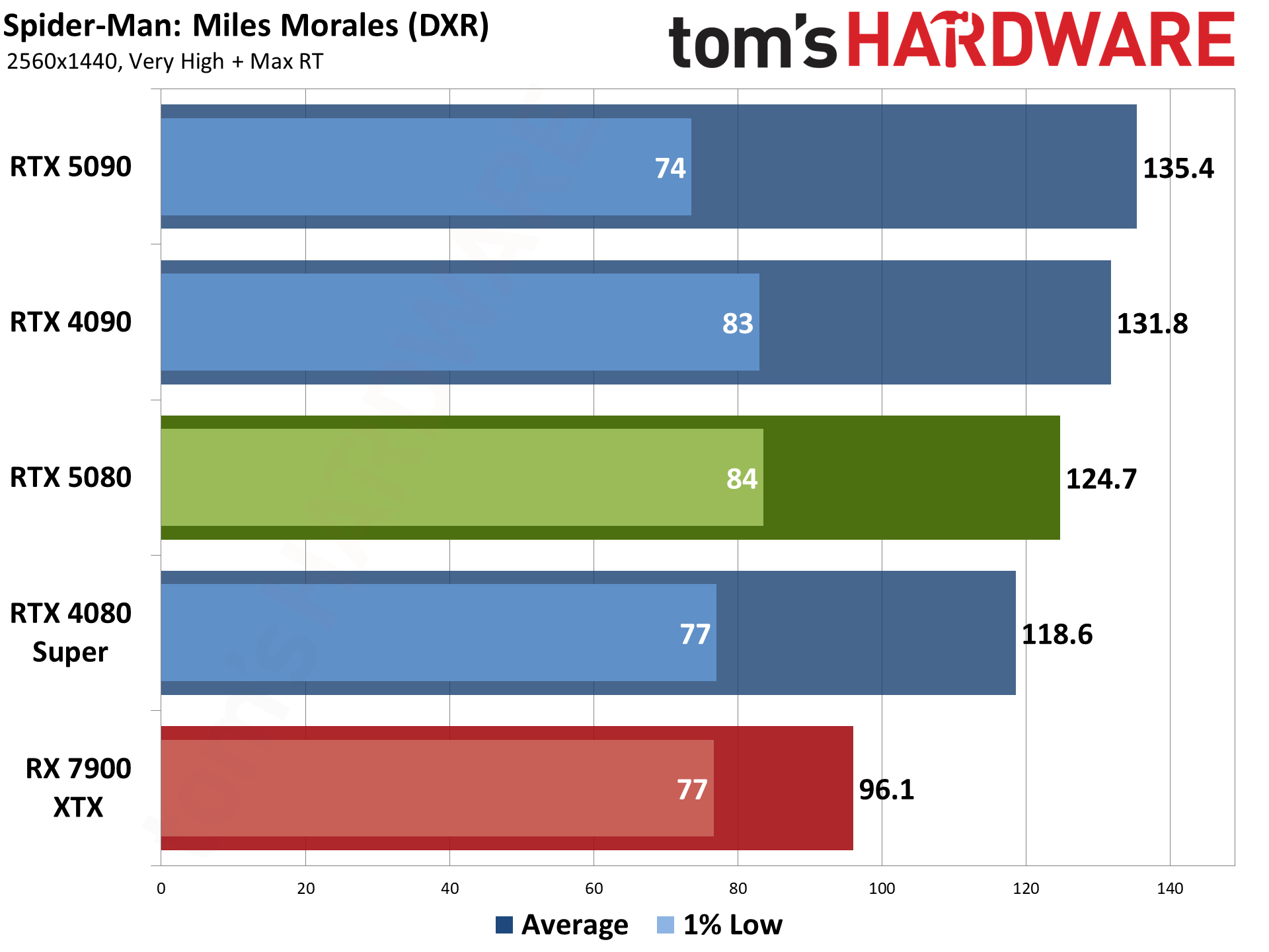
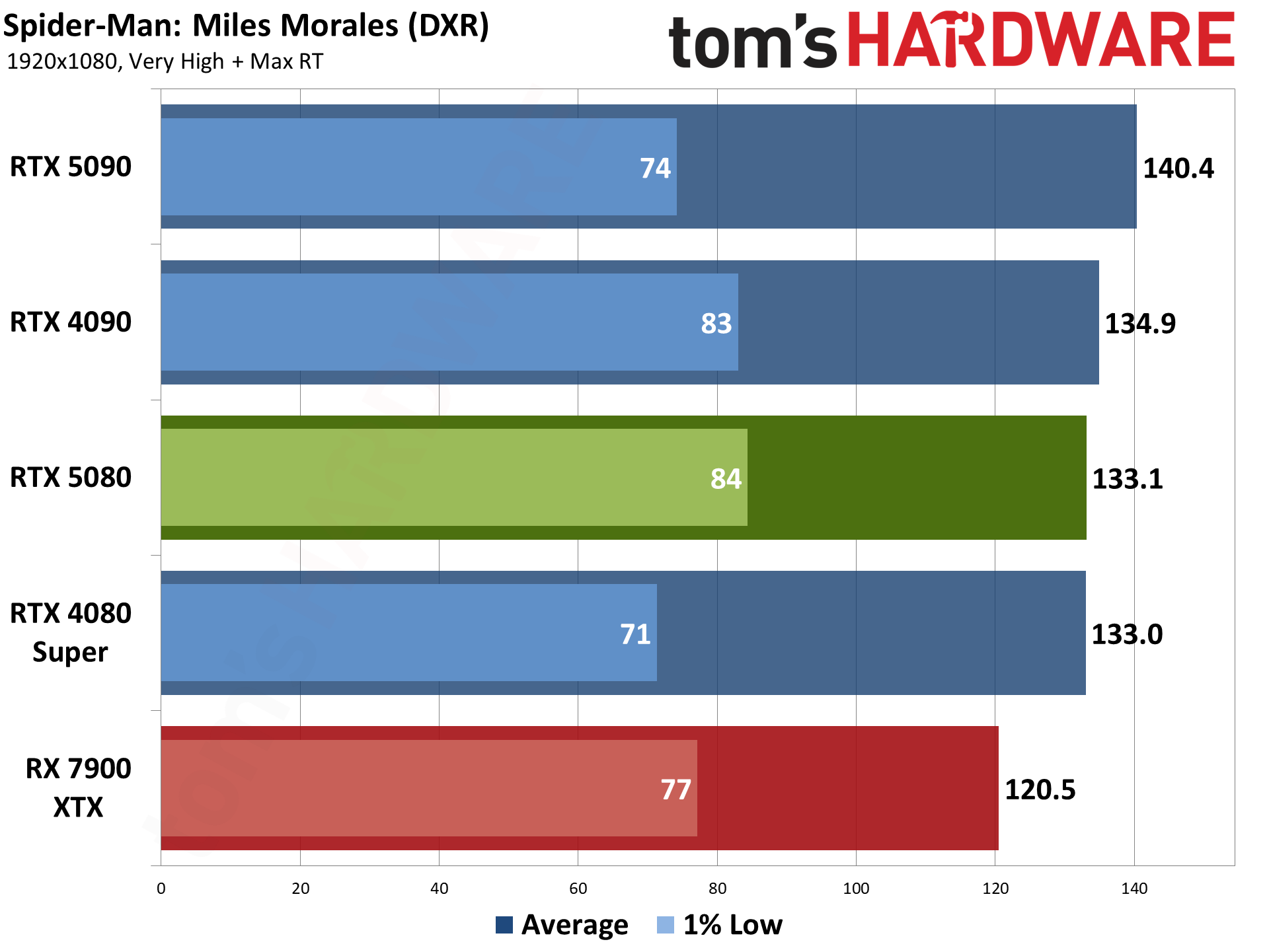
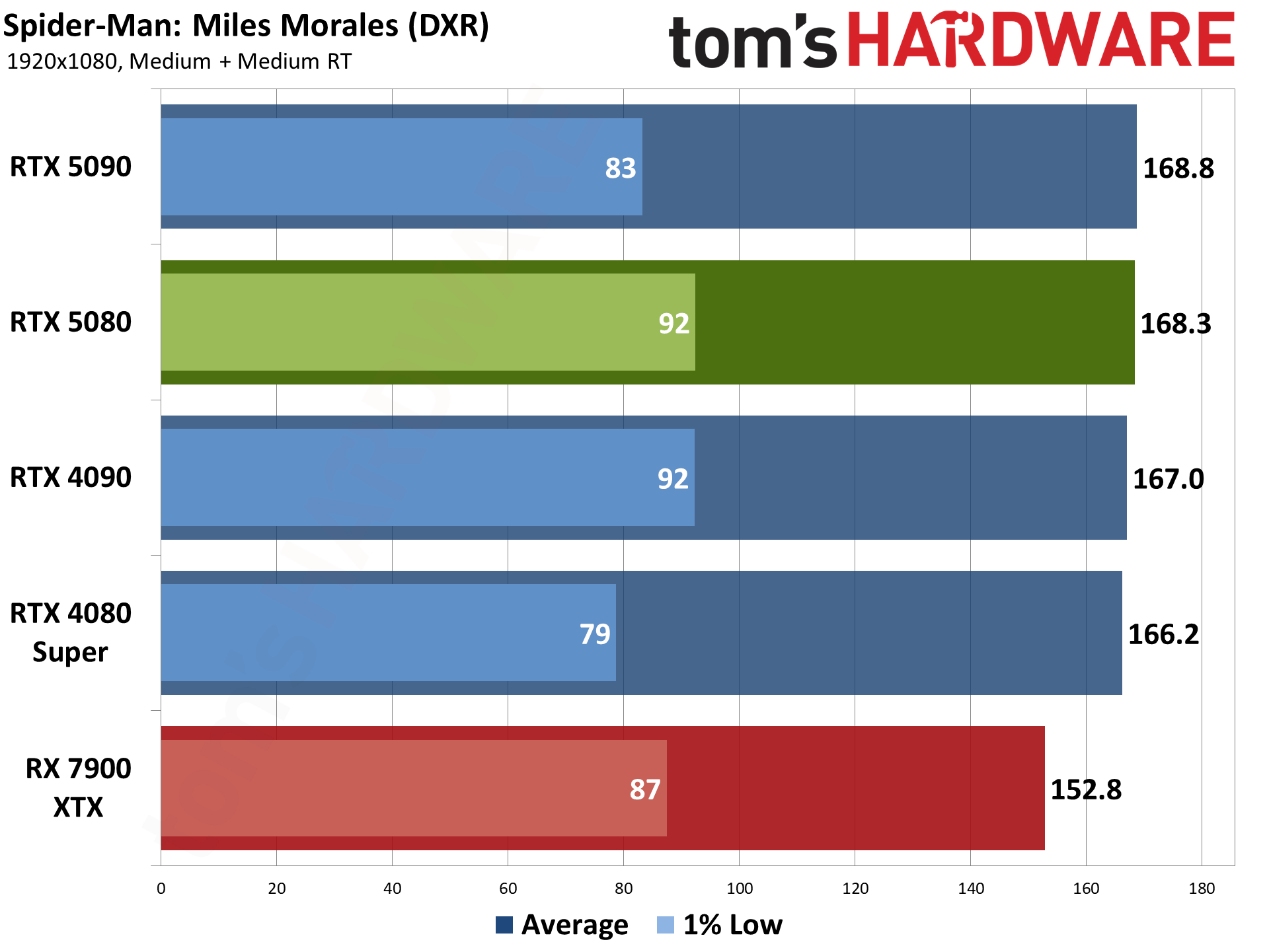
Last on our list of RT-enabled games, Spider-Man: Miles Morales doesn't look as nice with RT turned on as the previous Spider-Man: Remastered. The reflections are less obvious, and perhaps performance is better as a result. But beyond the RT effects, maxing out the settings in Miles Morales definitely needs more than 8GB of VRAM. The 16GB cards, like the RTX 5080, have no issues.
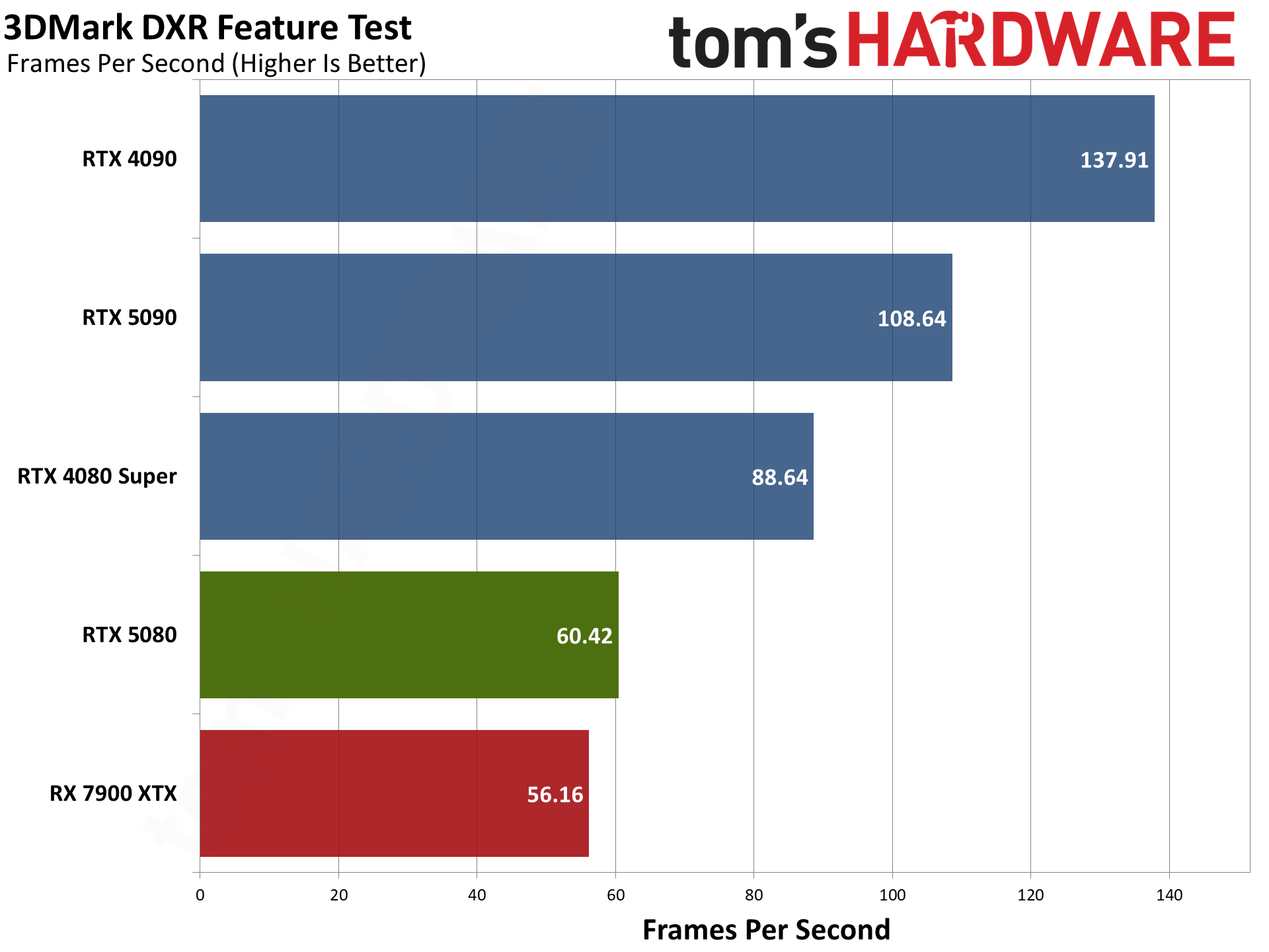
One final ray tracing benchmark we have is the 3DMark DXR Feature Test, where we report the average FPS rather than the calculated score. This is similar to full RT in a game, only done via a standalone benchmark and perhaps in a more vendor-agnostic fashion. Except, in this case, it appears to need further tuning (or driver tweaks) to run well on Blackwell GPUs. The 5080 barely beats the 7900 XTX right now, and the 5090 lands below the 4090. That's not supposed to happen, so clearly, some bug fixing needs to be done.
- MORE: Best Graphics Cards
- MORE: GPU Benchmarks and Hierarchy
- MORE: All Graphics Content
Current page: Nvidia RTX 5080 Ray Tracing Gaming Performance
Prev Page Nvidia RTX 5080 Rasterization Gaming Performance Next Page Nvidia RTX 5080 Full RT and DLSS 4 TestingJarred Walton is a senior editor at Tom's Hardware focusing on everything GPU. He has been working as a tech journalist since 2004, writing for AnandTech, Maximum PC, and PC Gamer. From the first S3 Virge '3D decelerators' to today's GPUs, Jarred keeps up with all the latest graphics trends and is the one to ask about game performance.
-
cknobman Pretty darn dissapointing.Reply
Sit back and let the impatient suckers get fleeced.
I'll happily wait for March and see if AMD can offer something worth buying at $500. -
King_V I initially looked at the TDP numbers, and thought: a new architecture, slightly more than 10% extra power draw for slightly less than 10% extra performance, on average, for gaming.Reply
But, that it actually doesn't exceed the power consumption during use of the 4080 Super is nice to see.
Still, yeah, if you're in the market for a GPU with this performance, and if the price is the same, the 5080 is the way to go.
But, I feel like the odds are that, at least for a few months, the 5080 will cost more, and the 4080 Super prices MIGHT come down a little with the release of the 5000 series. If so, that situation could make the 5080 a hard sell. -
spongiemaster Reply
5090 is more than 50% faster than 5080 which is ridiculous. There's something to be said for trying to upsell, but that's way too big a gap in performance and cost between the 5080 and 5090. Also sounds like there are issues with volume production as well. Getting people to move up doesn't work if you don't have product to sell them. If you're in the market for a 5080, wait for the refresh. Will likely have more VRAM and will hopefully gain some meaningful ground in performance.Gururu said:It's so cheap though, $1000 less than the 5090. -
TCA_ChinChin How is "second fastest GPU" a positive? Its not even true, the 4090 is the second fastest GPU. This is the worst 80 series release by Nvidia for a while now. Im pretty sure the last 4-5 generations of 80 series cards have outperformed the previous generation flagship (except the 2080 vs 1080ti which was also a quite disappointing generation).Reply -
Elusive Ruse Thank you @JarredWaltonGPU for the detailed review and pointing out the flaws of this underwhelming product. The 80 class is officially dead? I wish you had the time to include the 3090 as well so we could see how 4080 performed against it and in turn highlight the fact that the 5080 doesn’t even come close to the 4090.Reply
I was in the market for a 5080 but my excitement died down gradually with the leaks about its specs over the past few months and with the reviews out I’m definitely not planning to throw €1200+ at it. -
spongiemaster Reply
5080 is 50% faster than the 3090 at 4k. So a decent upgrade for 3090 users for less money than they spent on their 3090 though there is a memory downgrade. Still would recommend waiting for the refresh.Elusive Ruse said:I wish you had the time to include the 3090 as well so we could see how 4080 performed against it and in turn highlight the fact that the 5080 doesn’t even come close to the 4090. -
I'm getting the impression that the reason behind 5080 being so disappointing, is Nvidia trying to funnel consumers into buying the extremely inflated 5090.Reply
